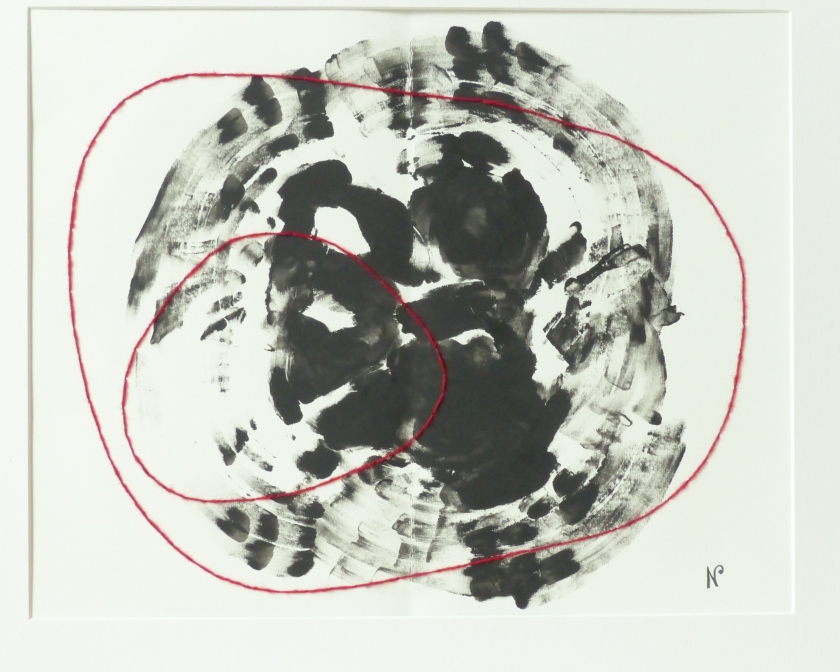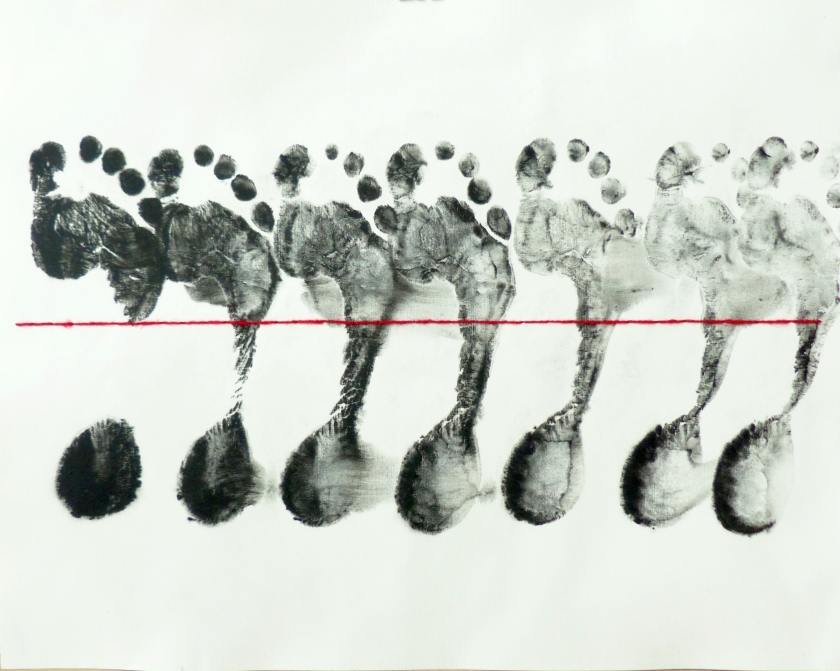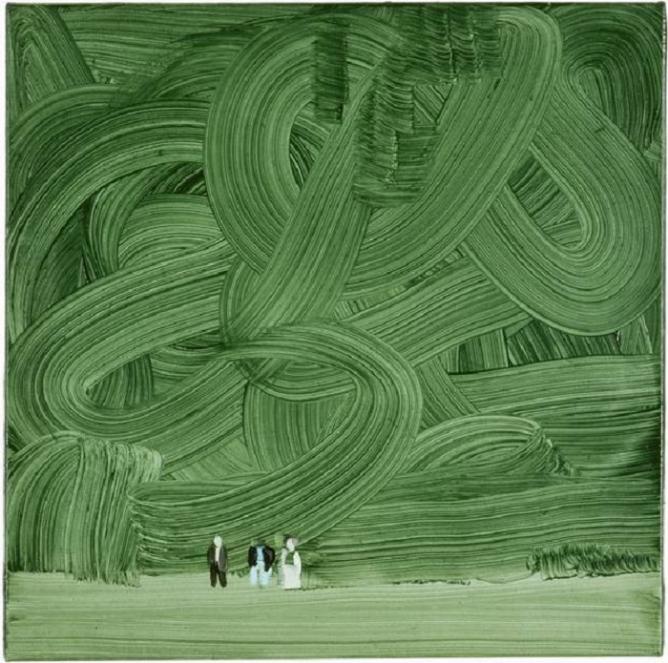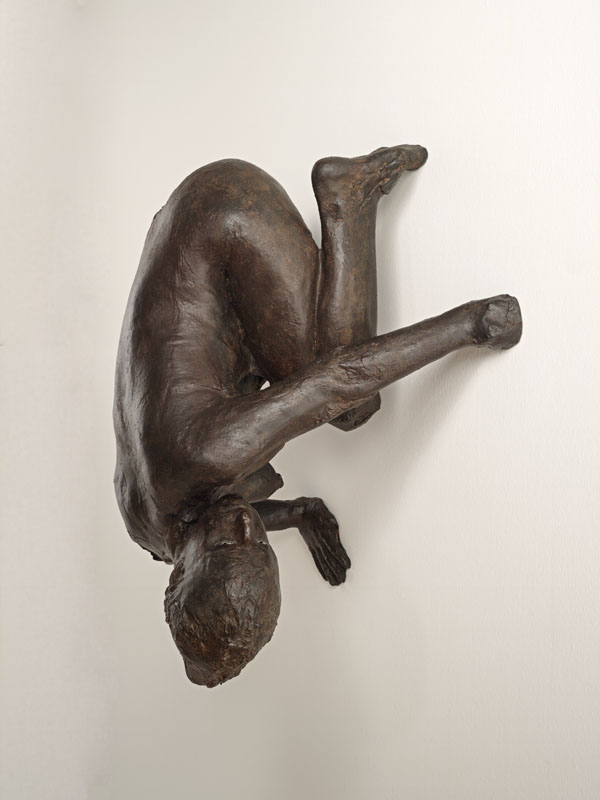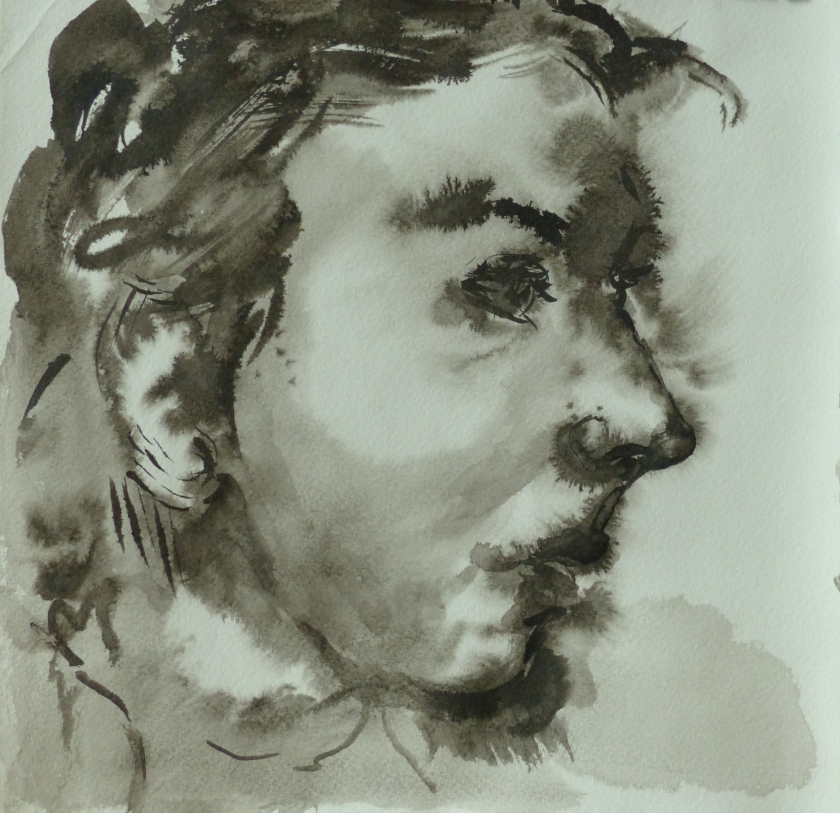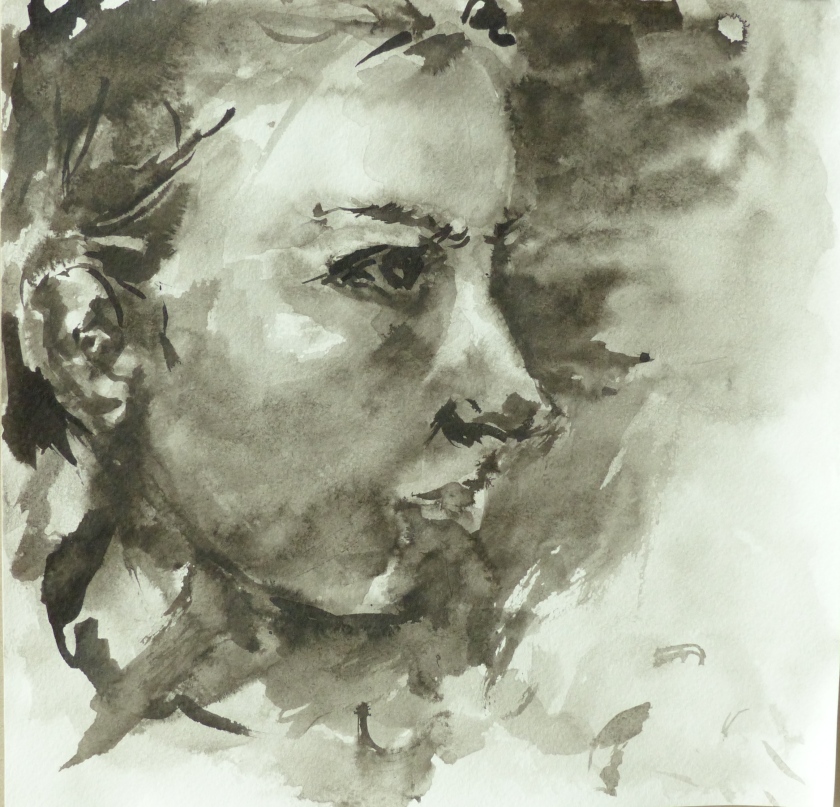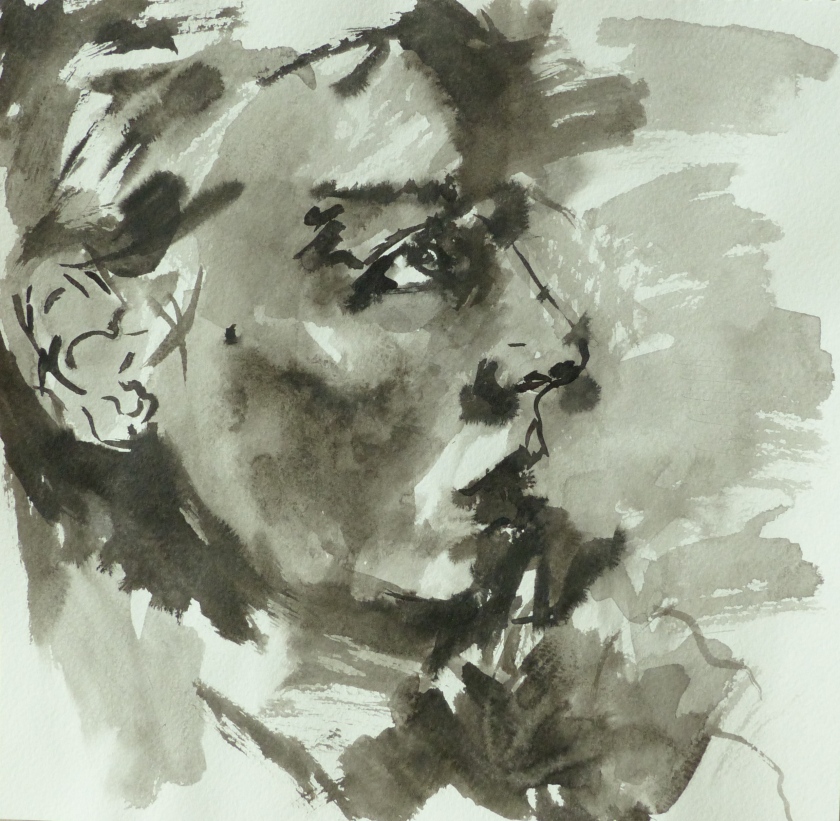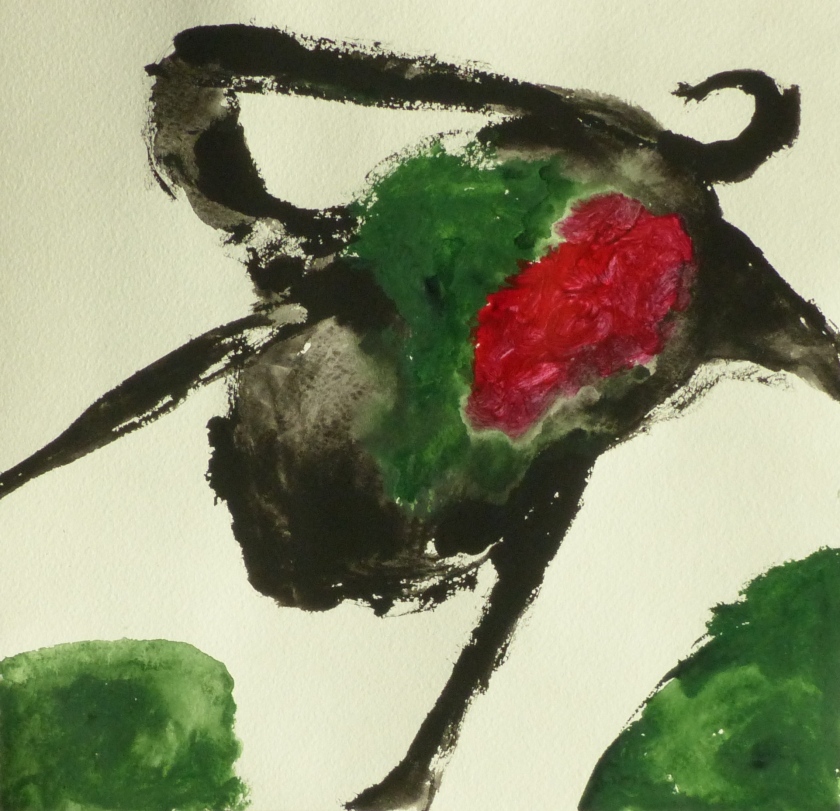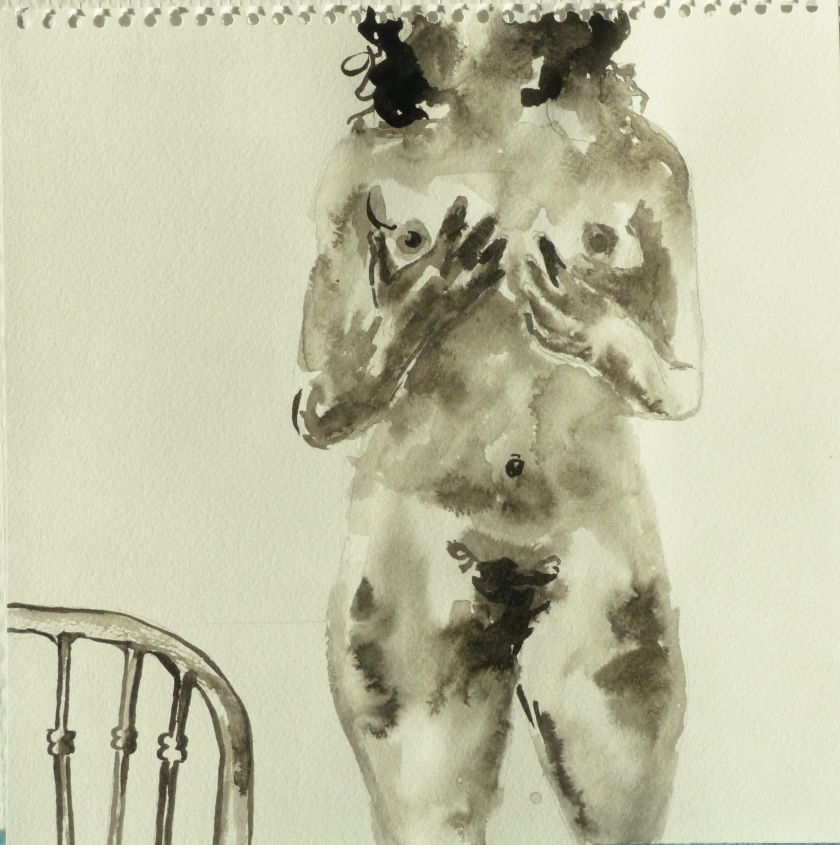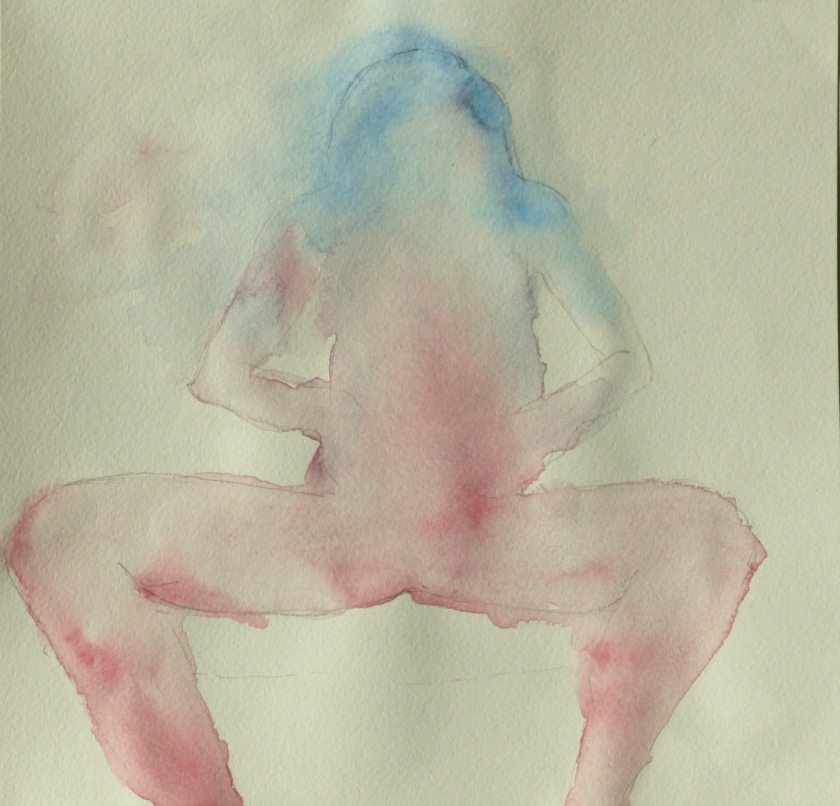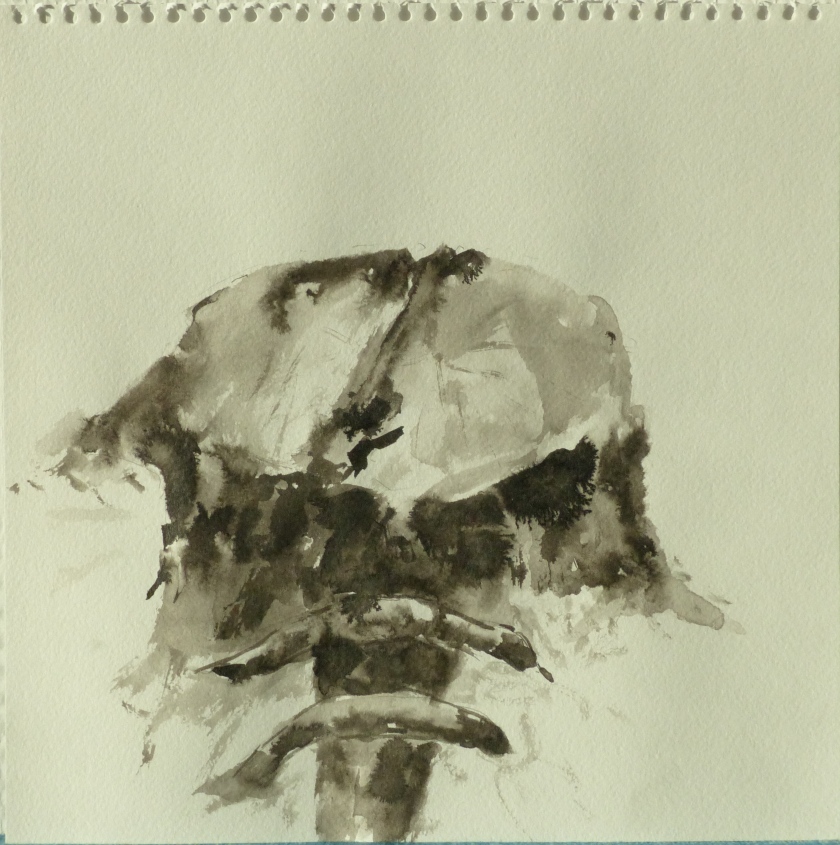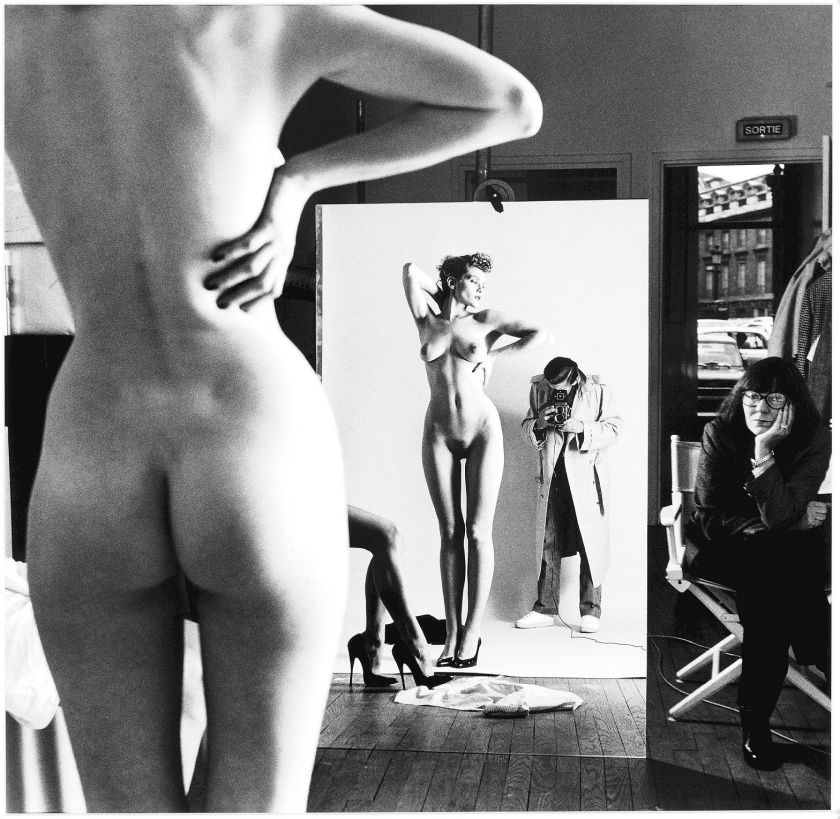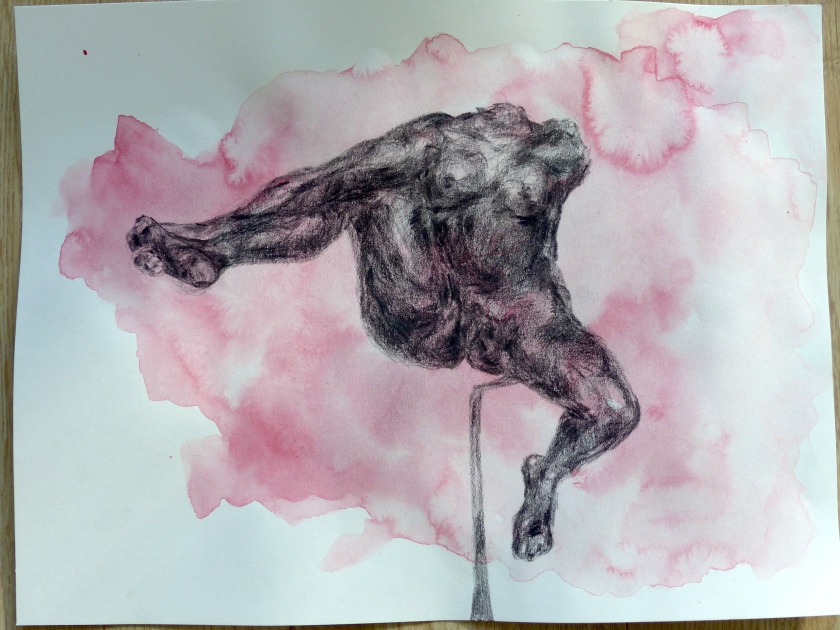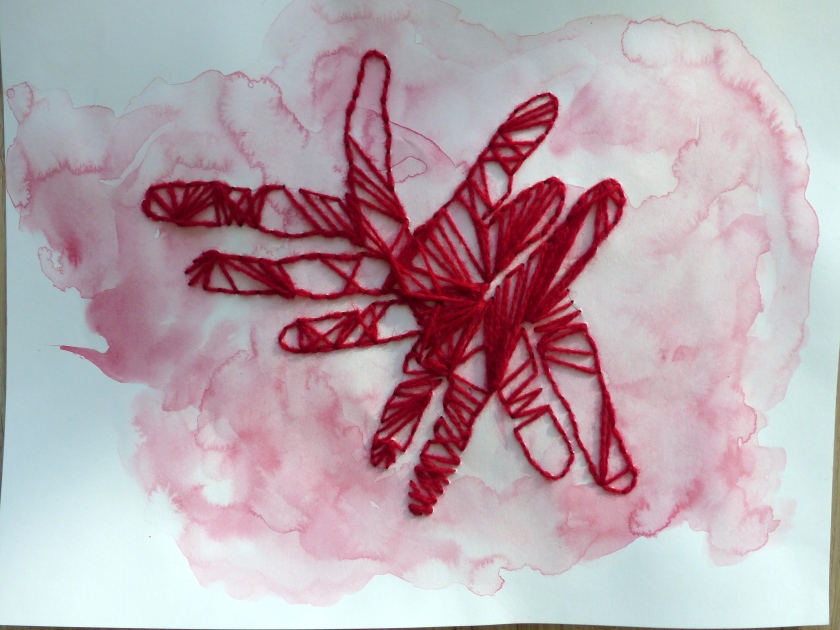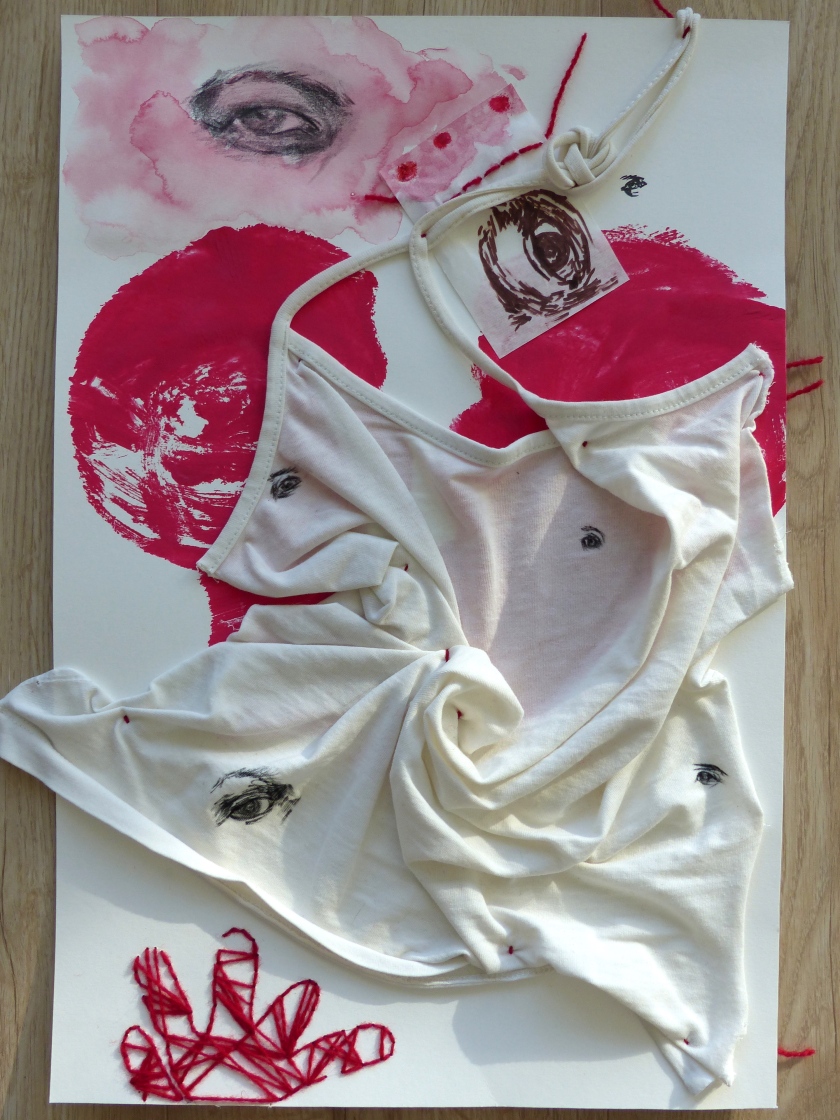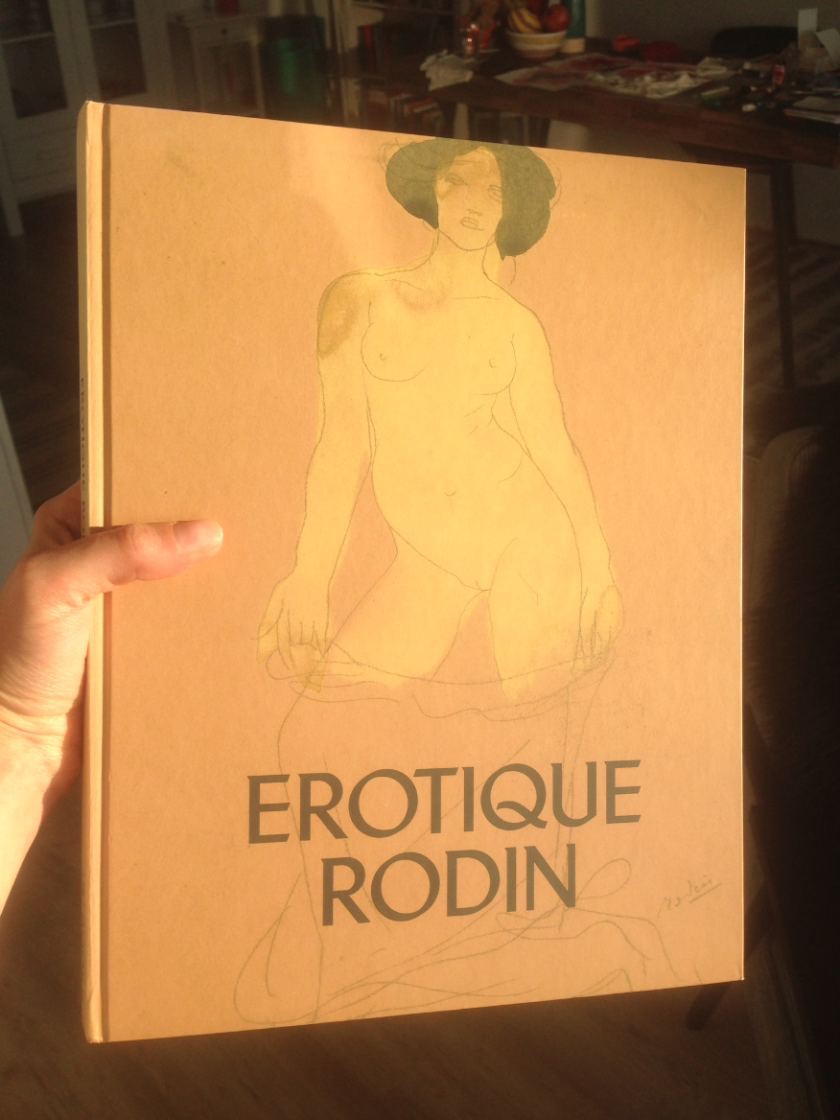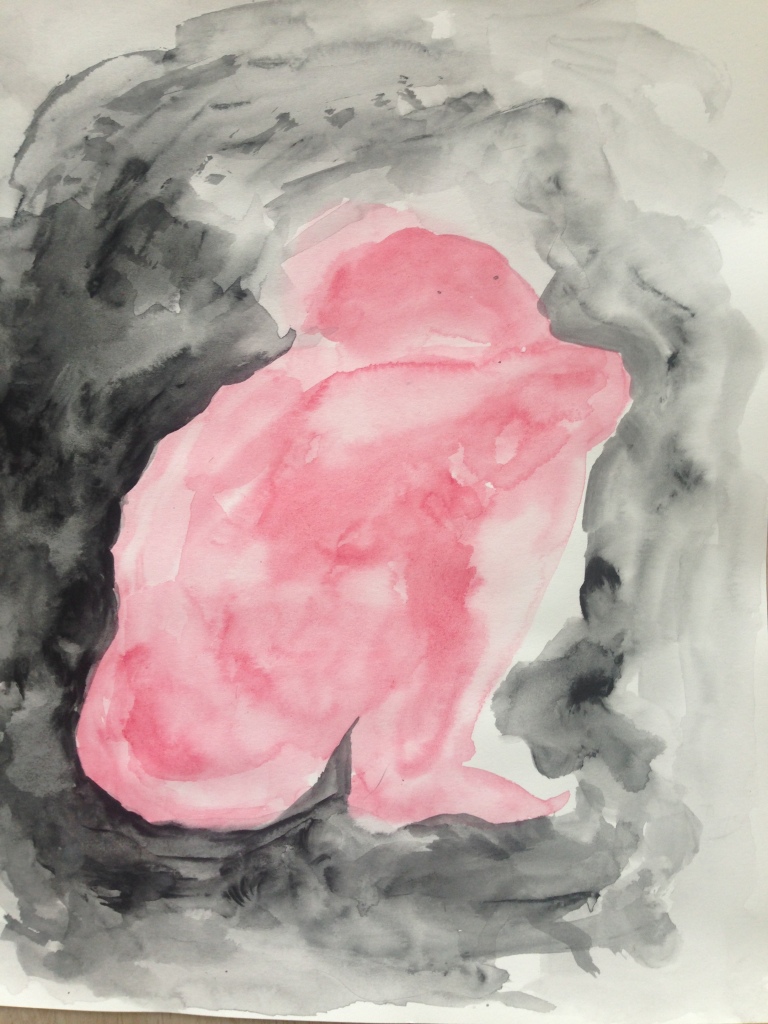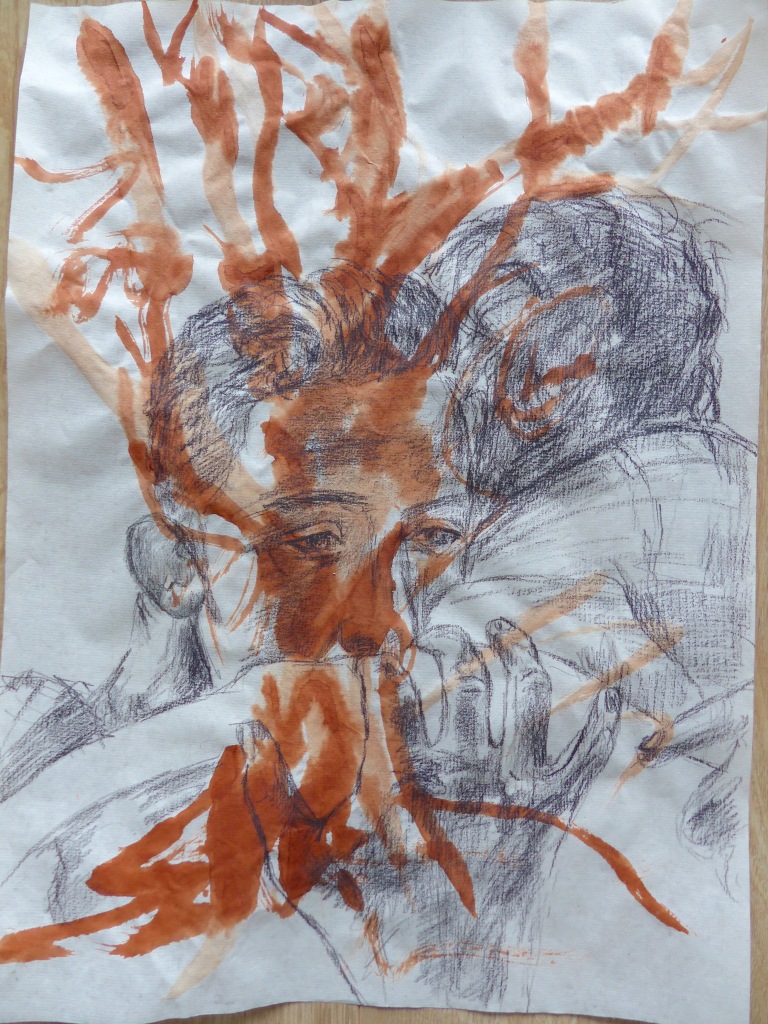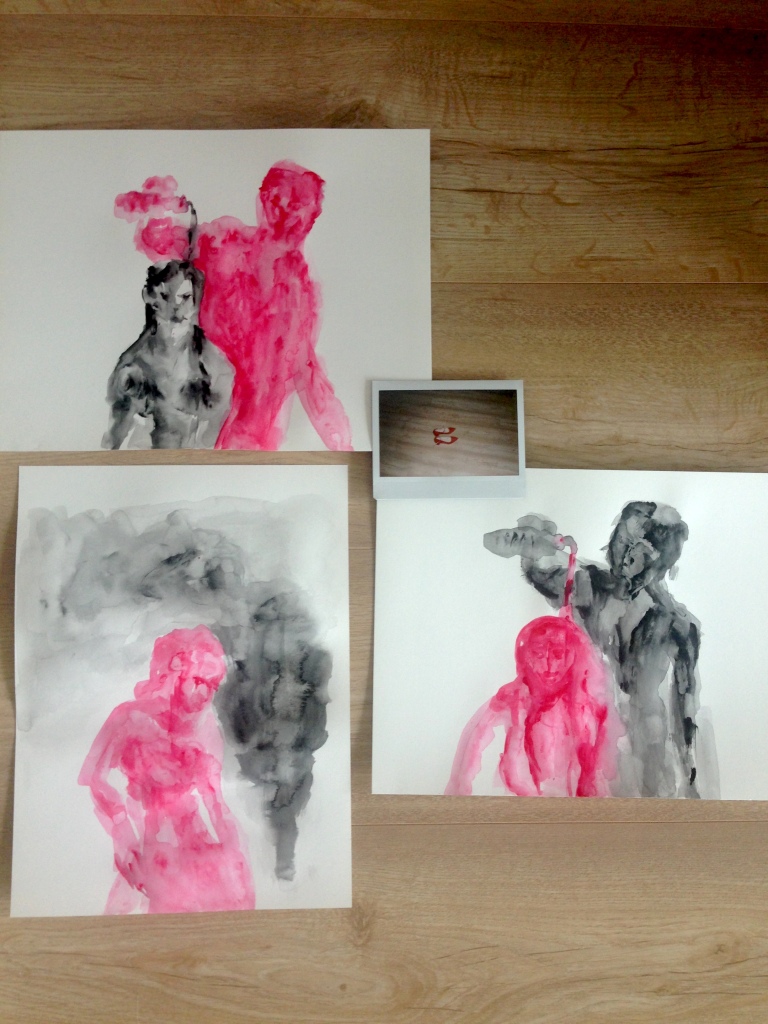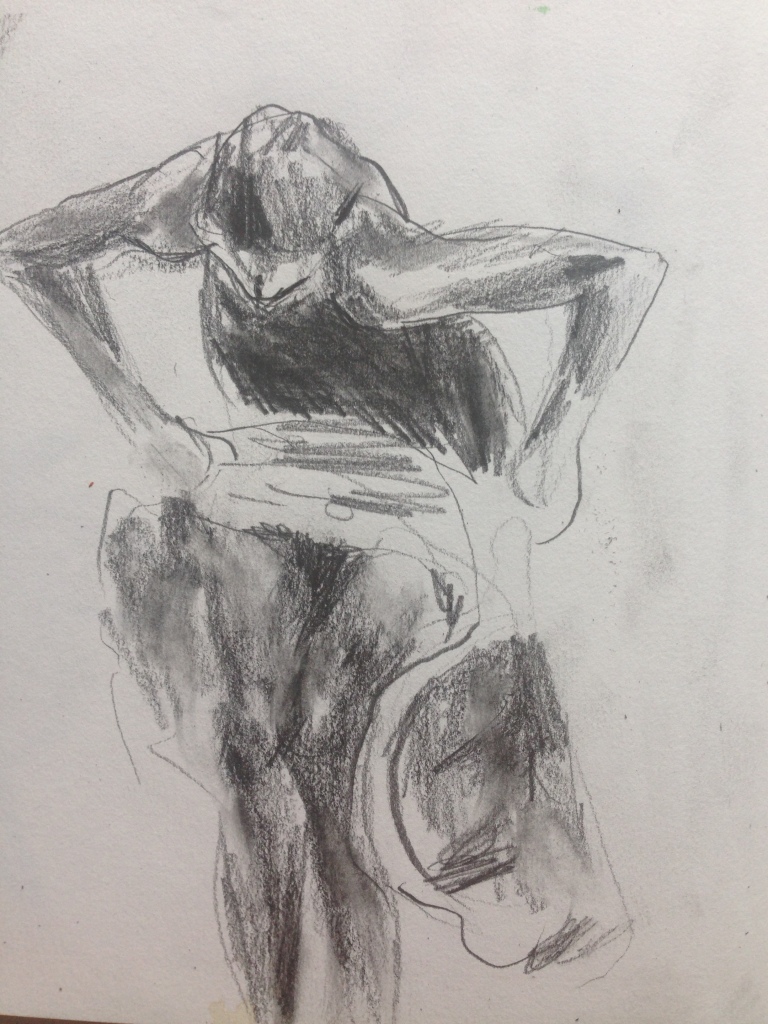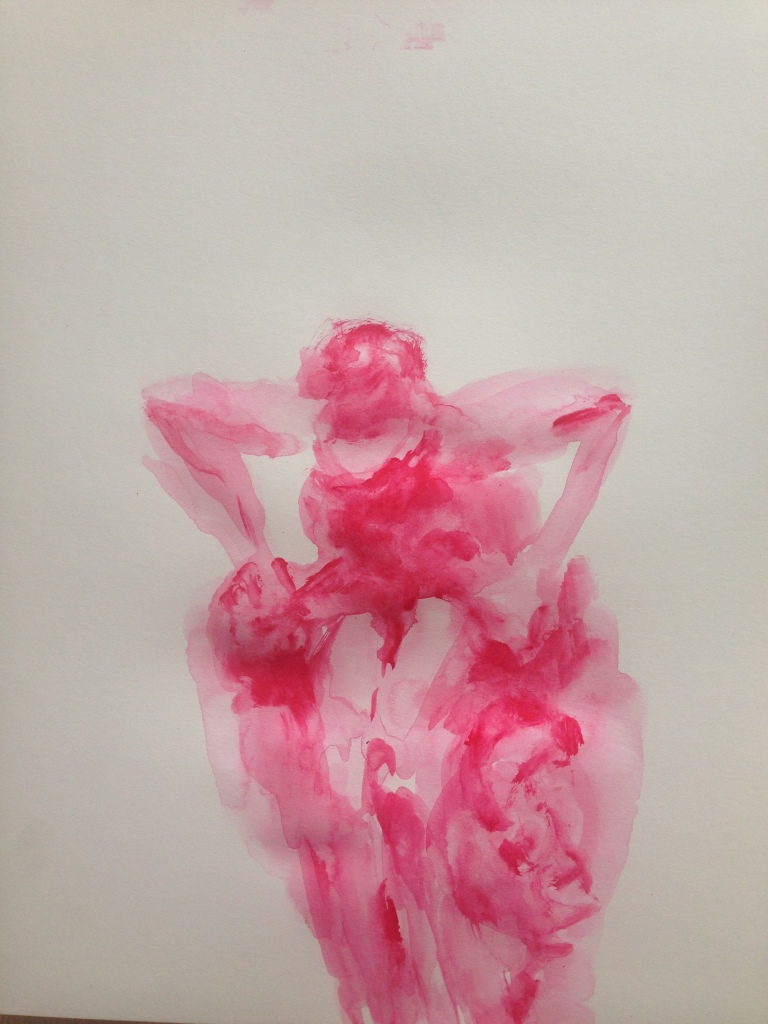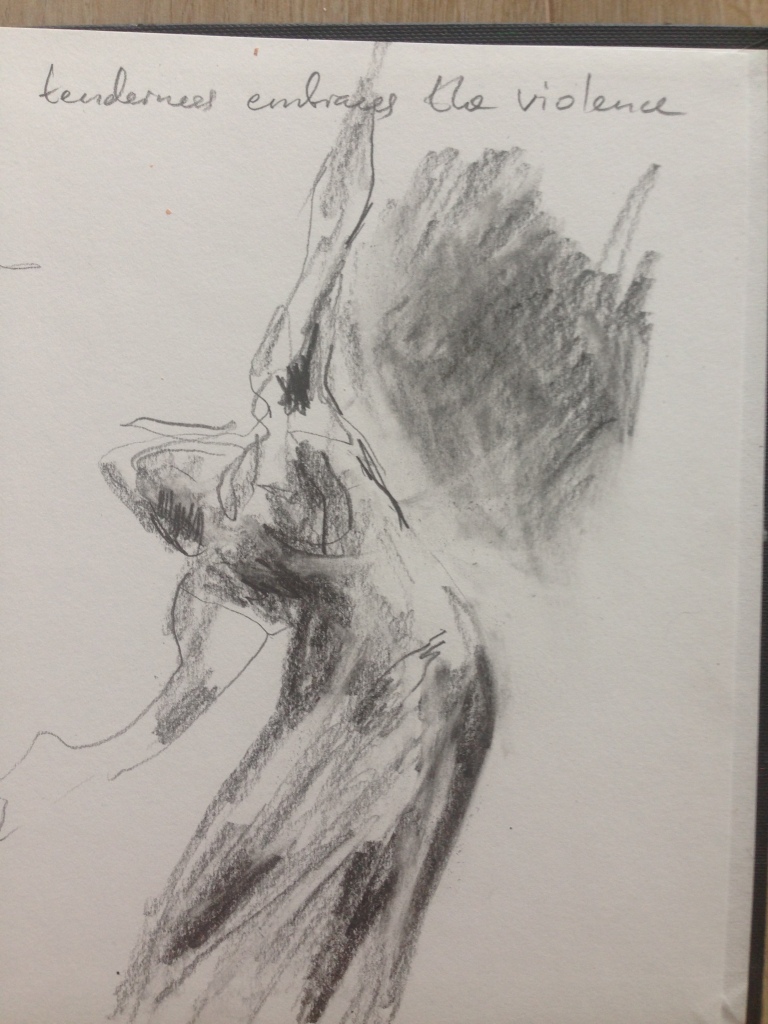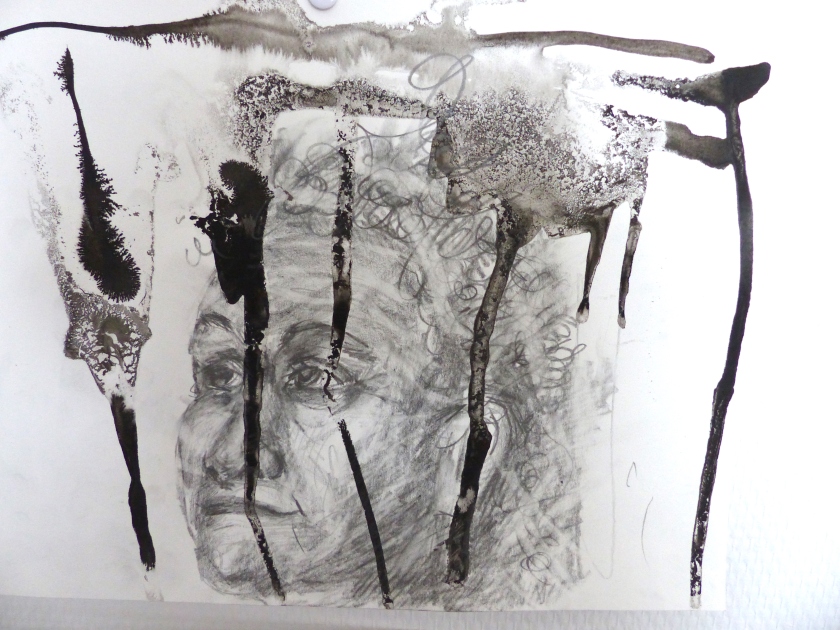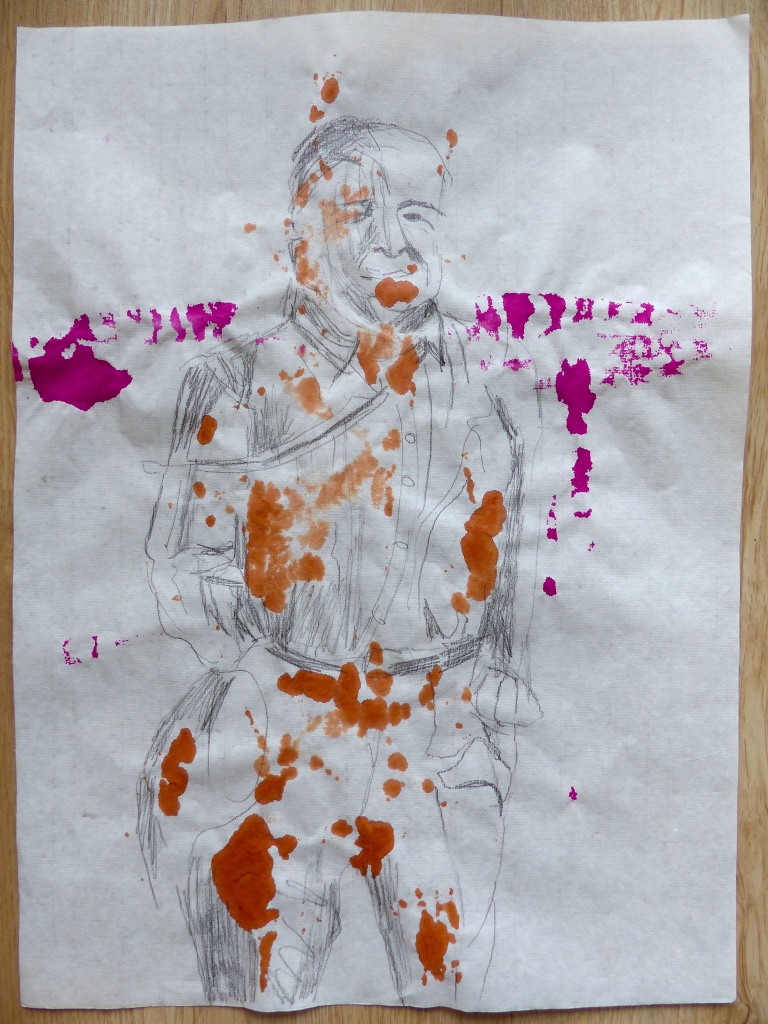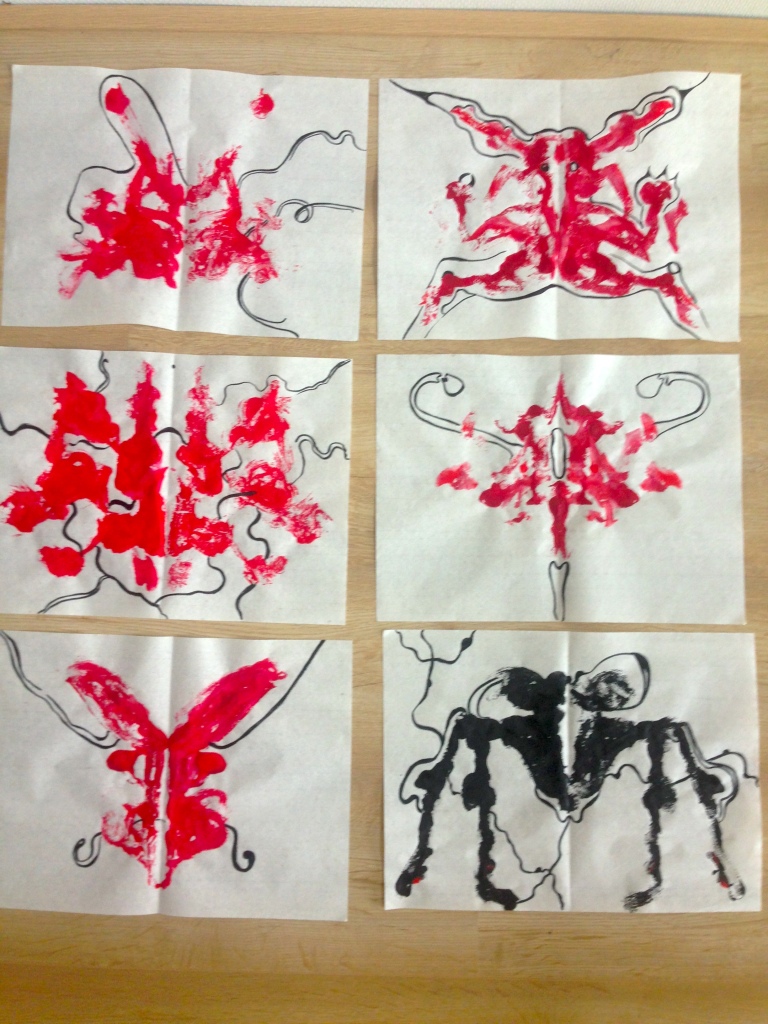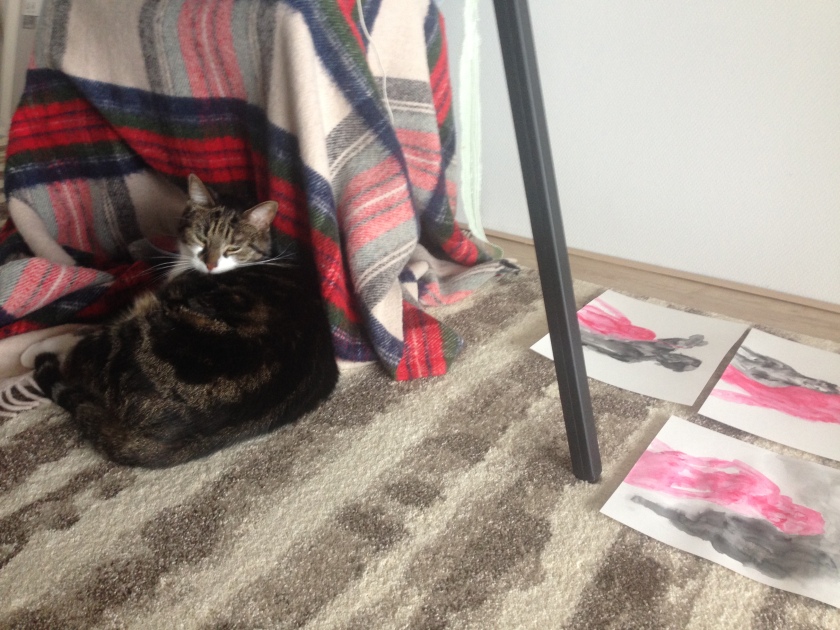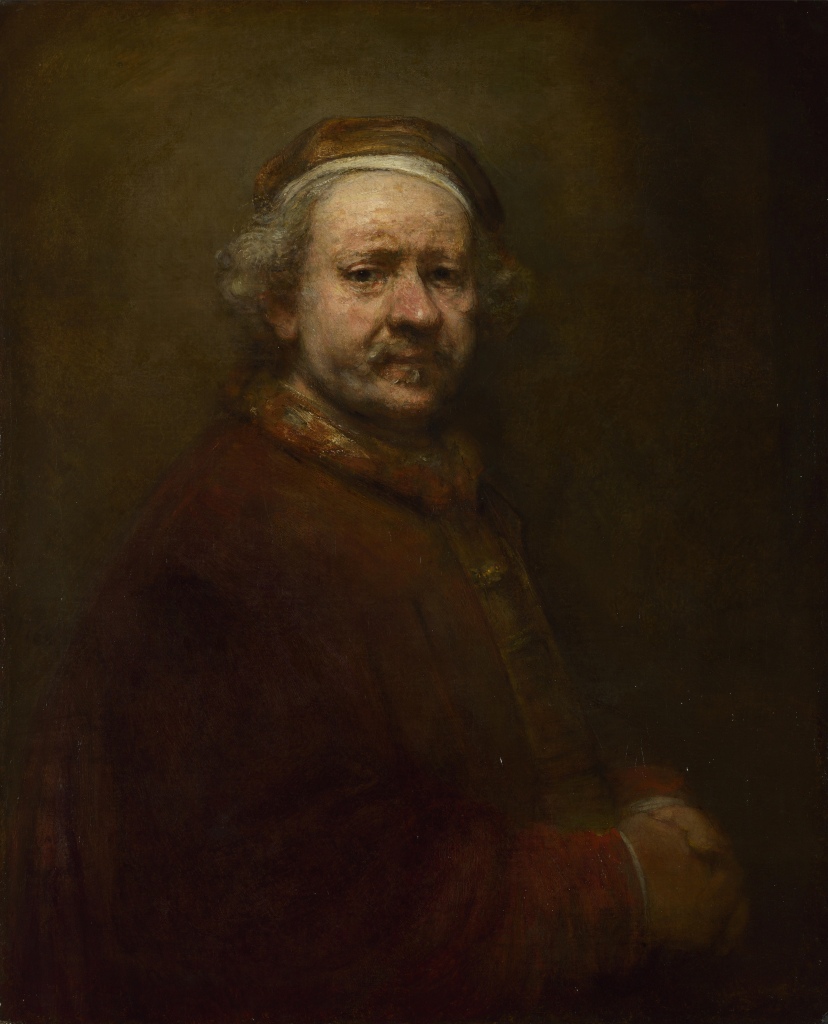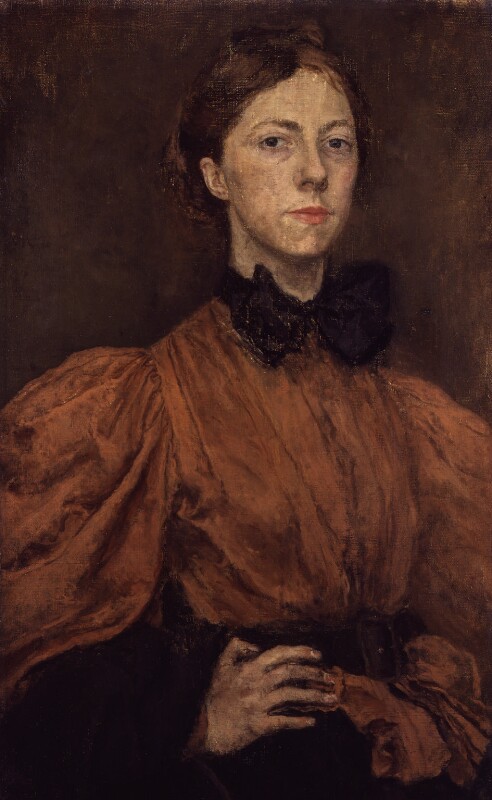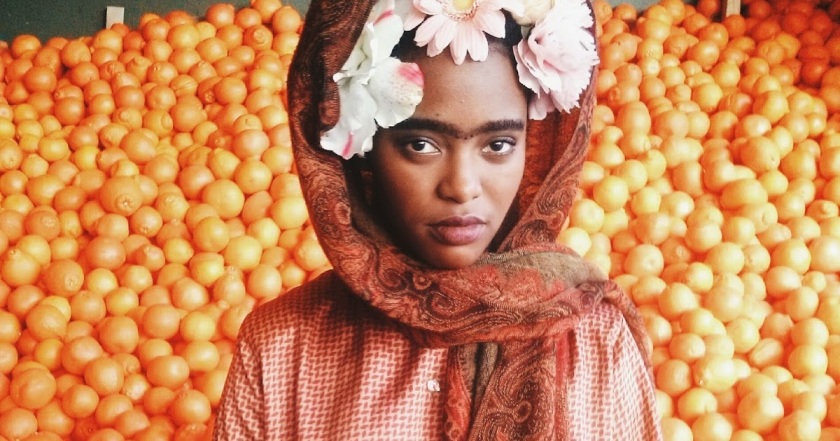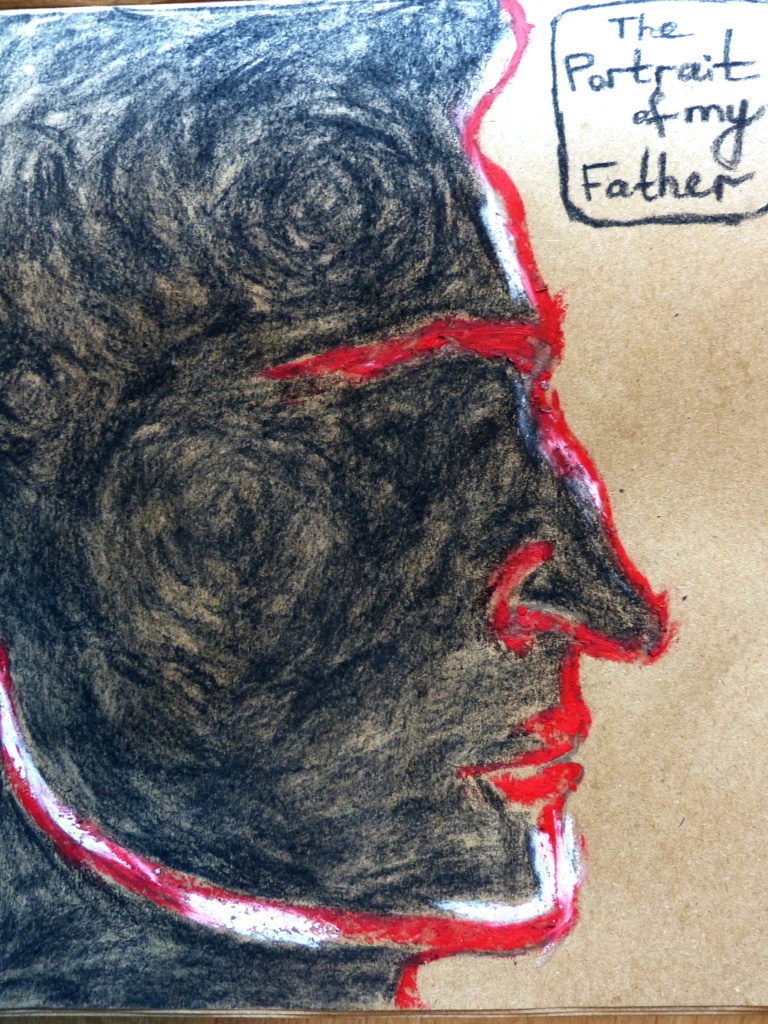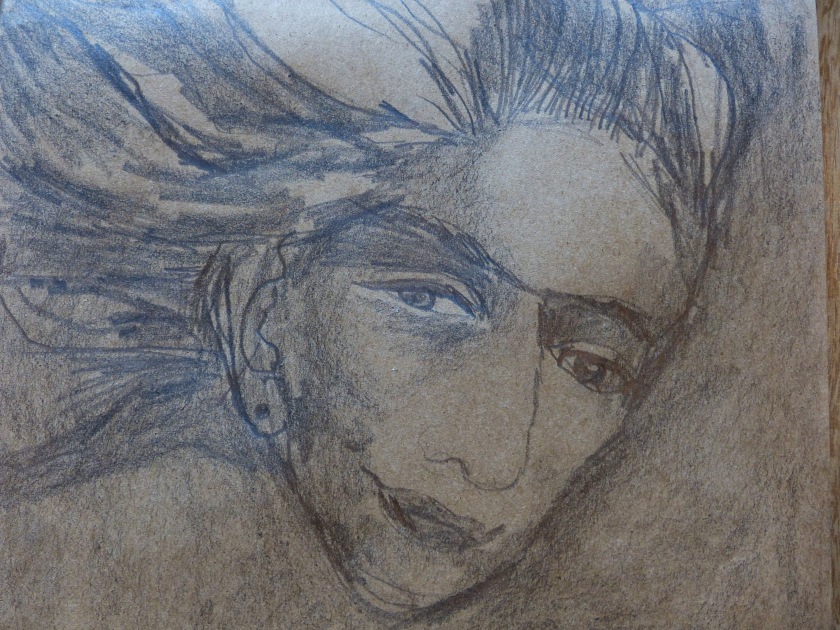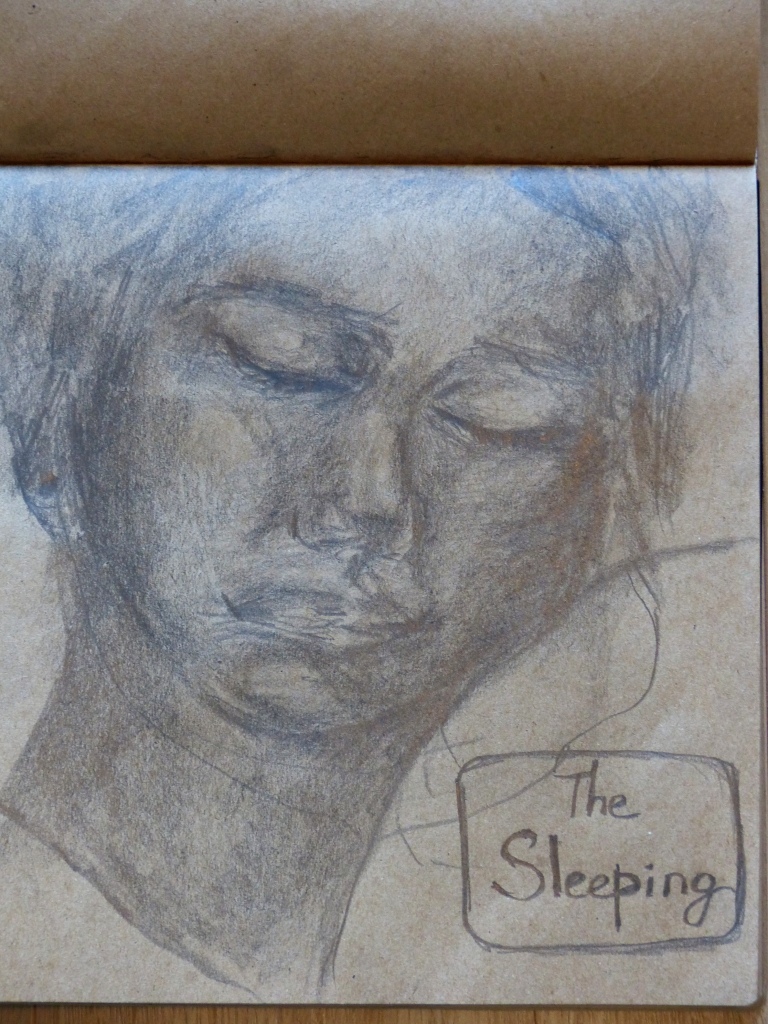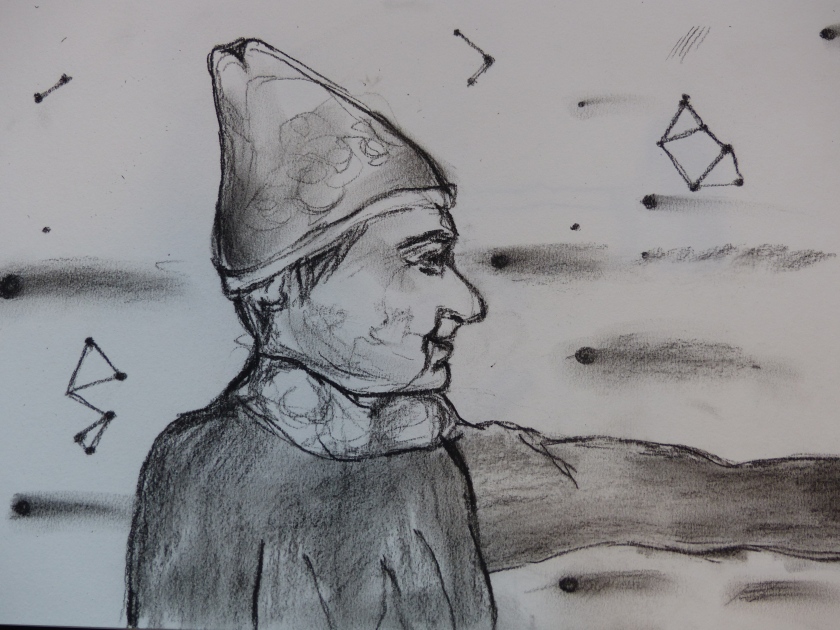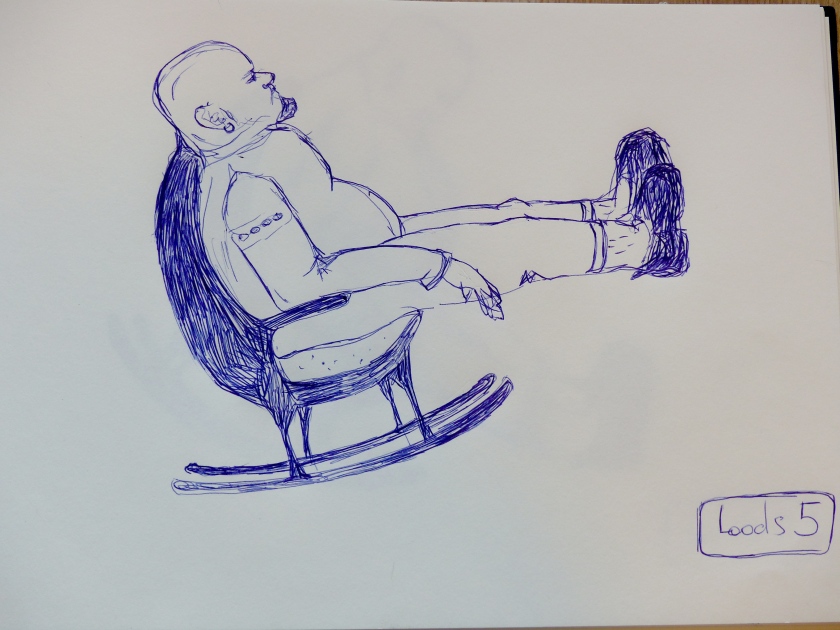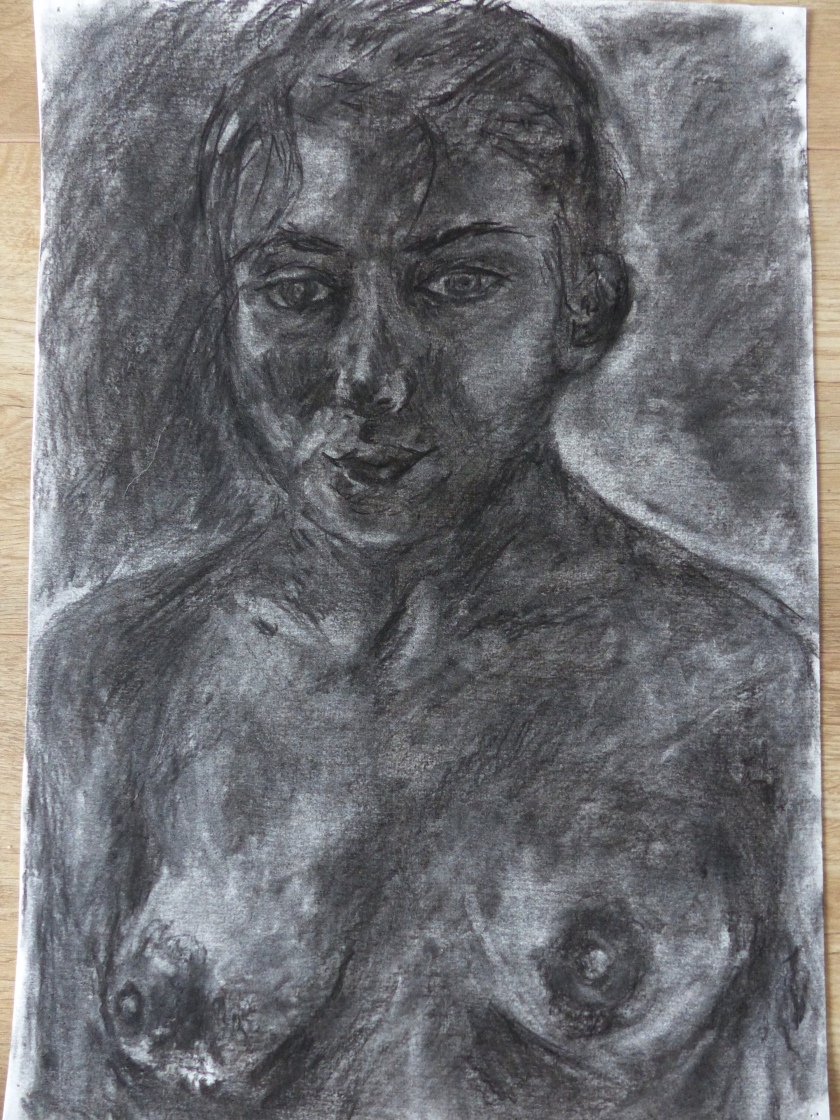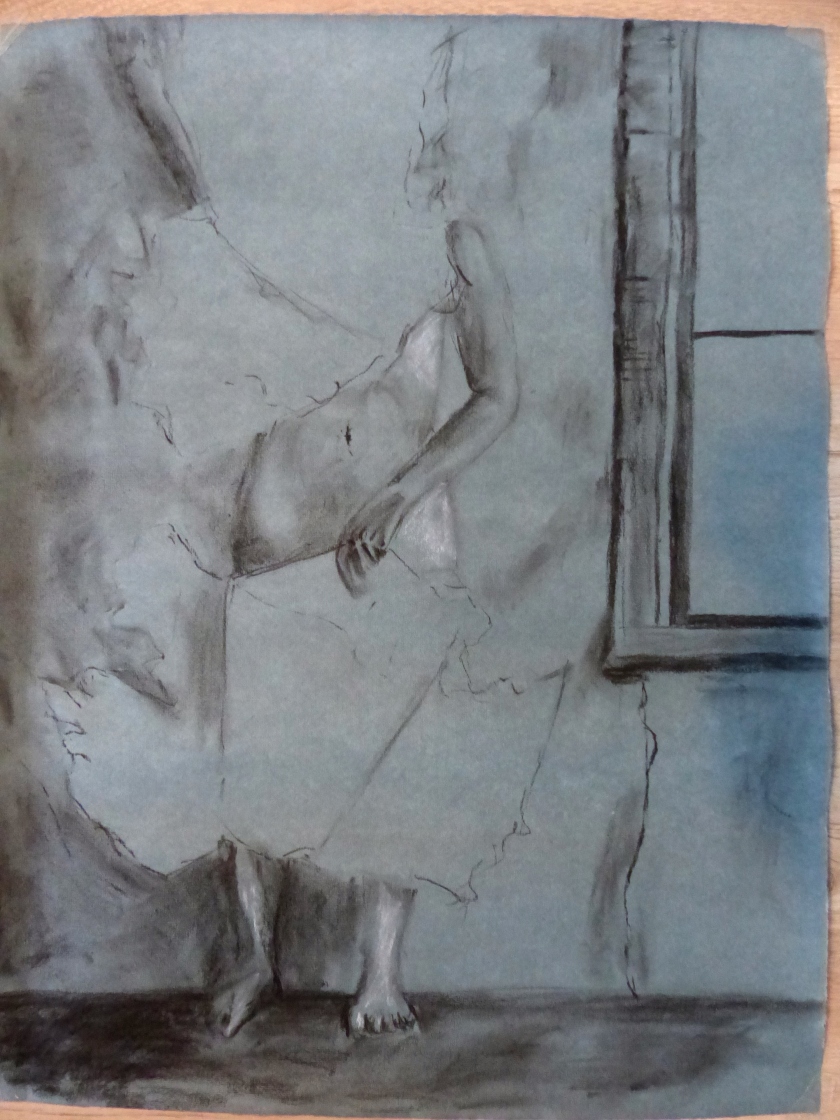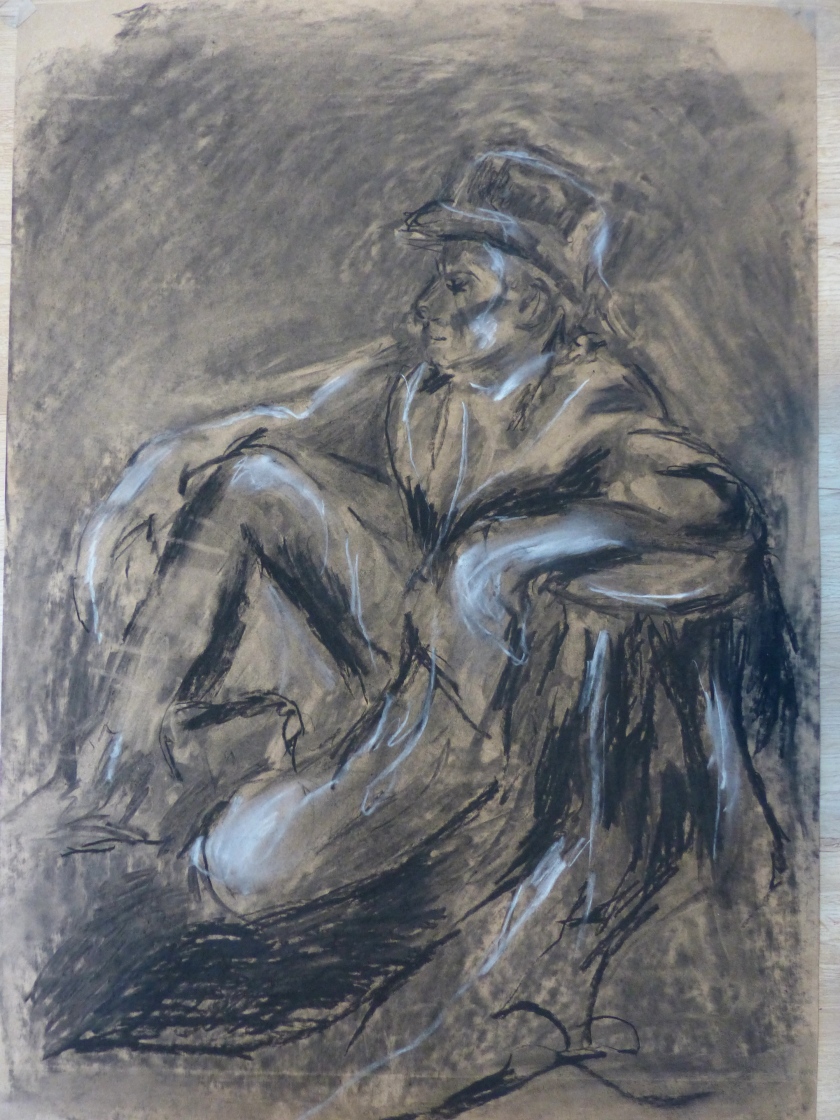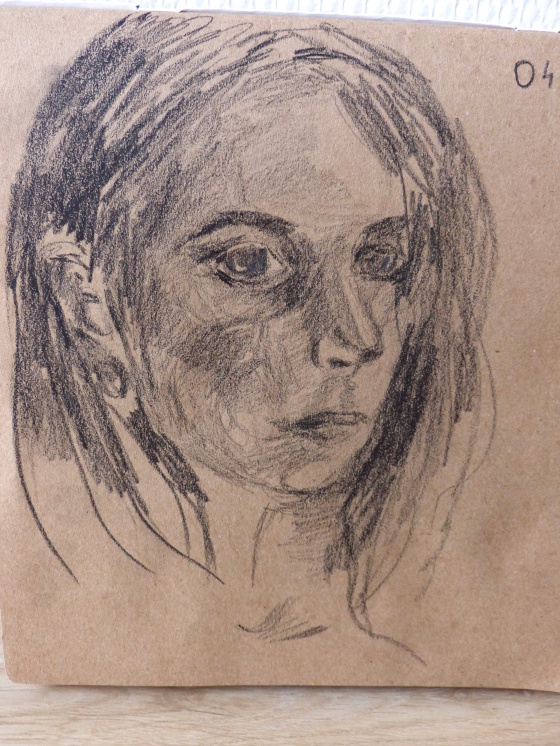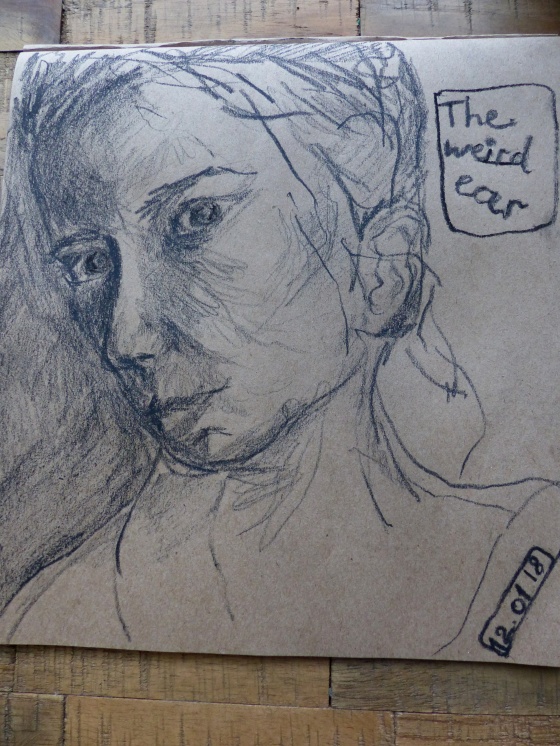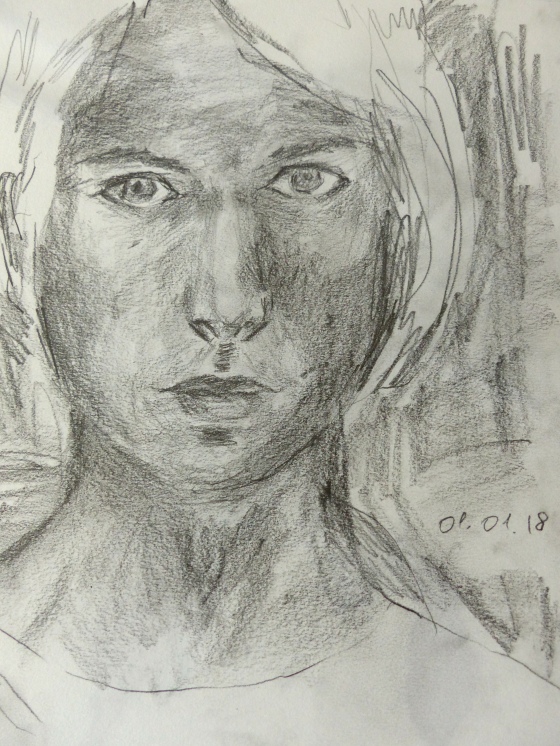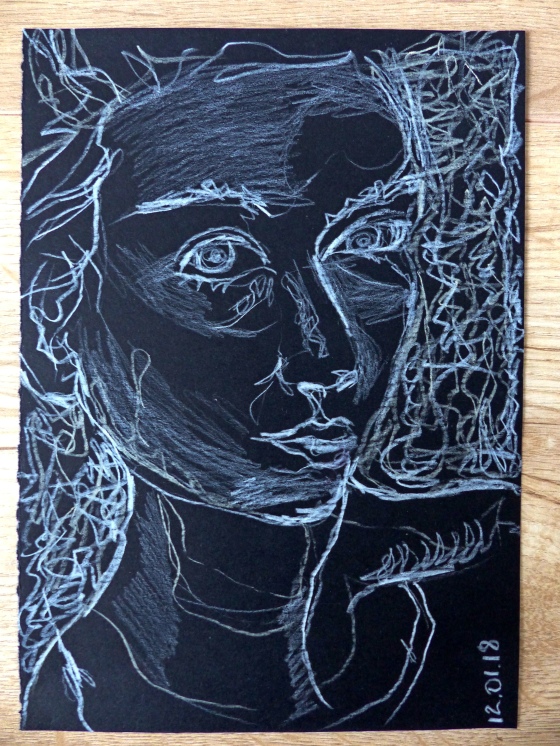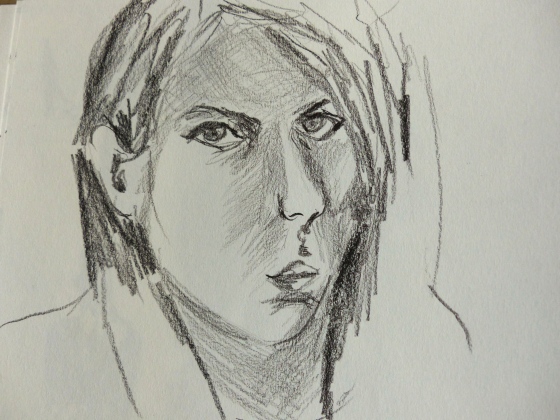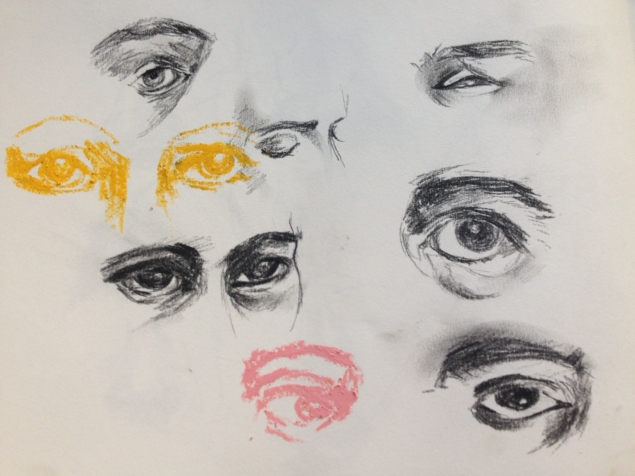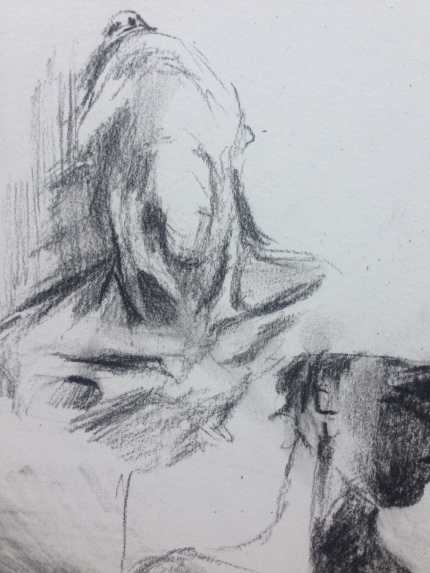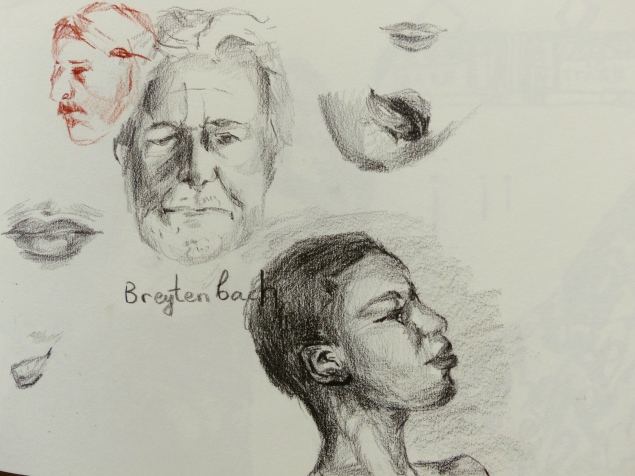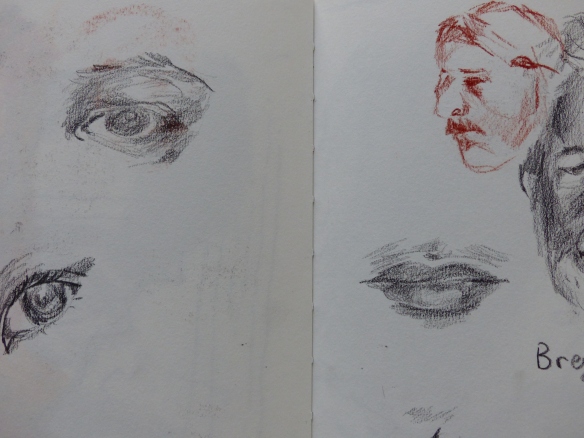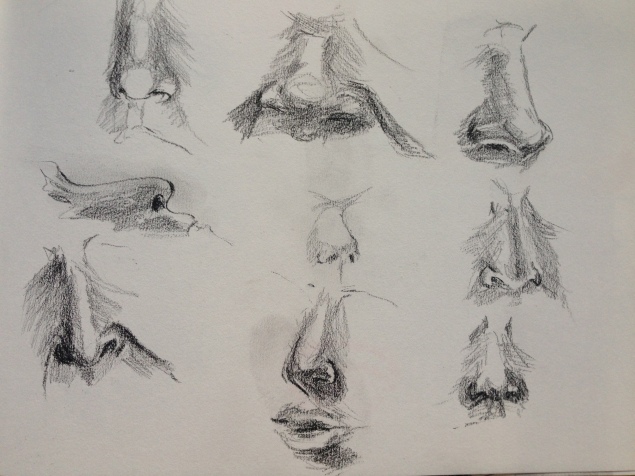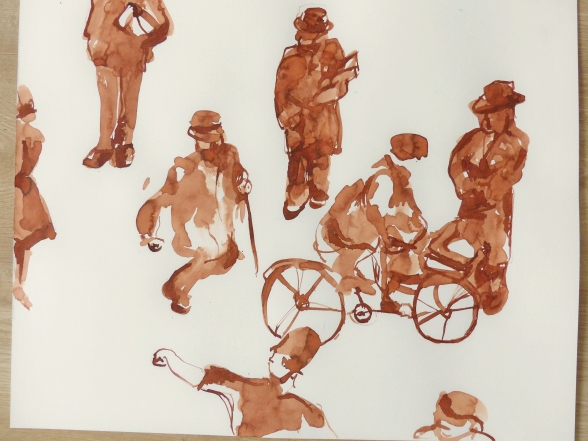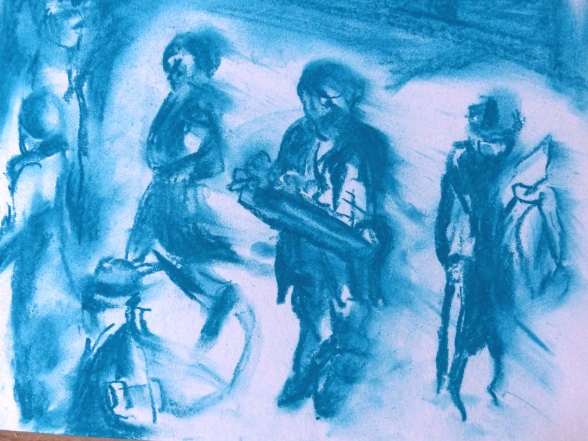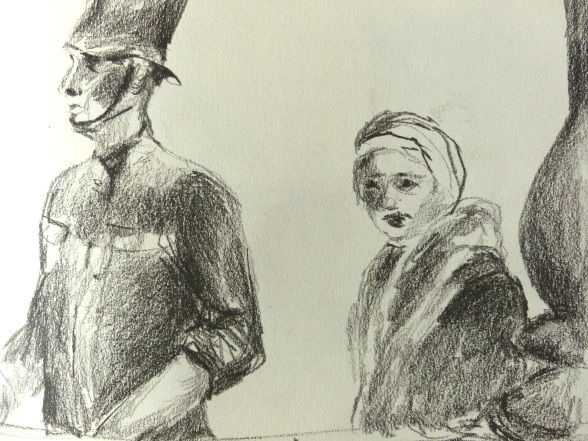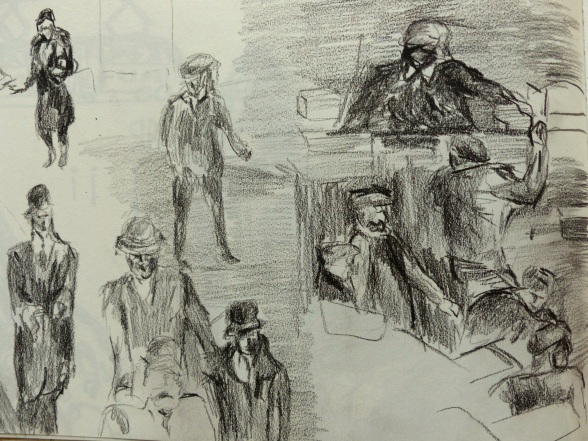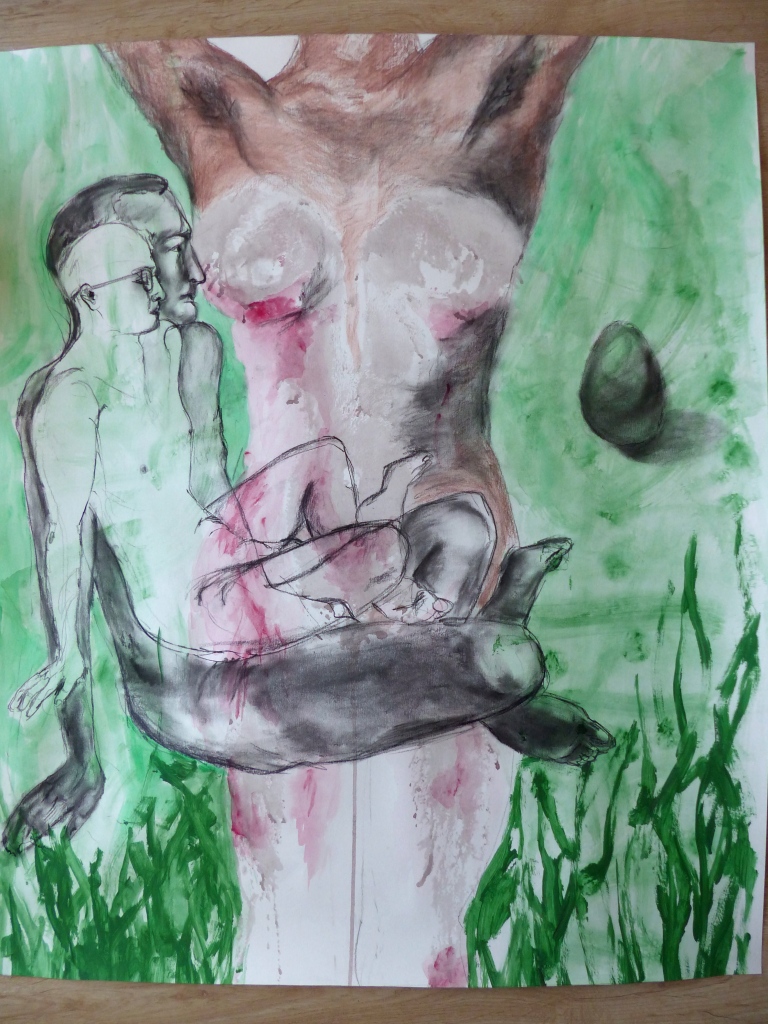
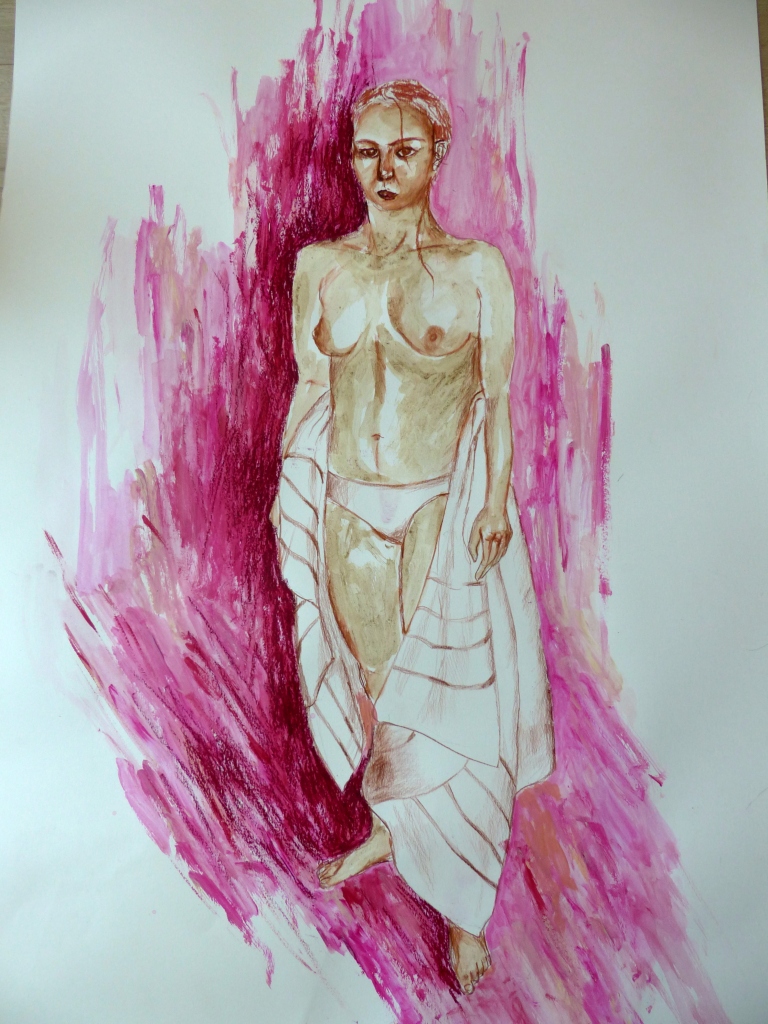
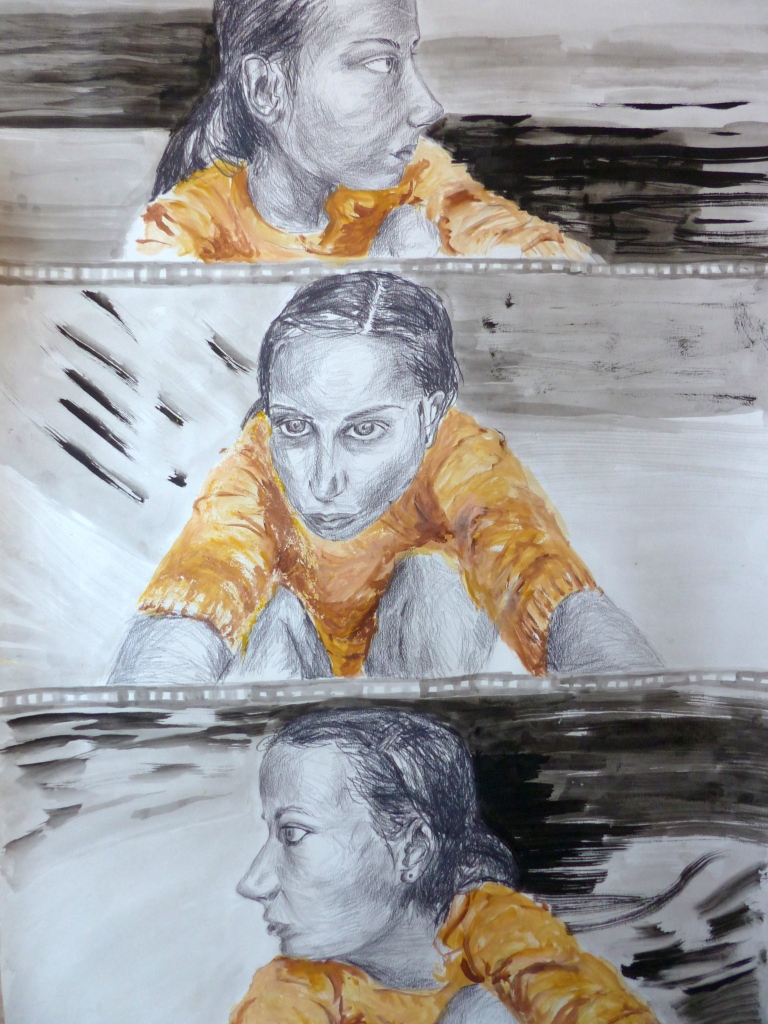
Reflection on Part Four and the Assignment
I think I paint with more awareness and zest than I draw. This probably reads like an odd introduction to the reflection on my experiences with drawing. In the beginning, I expected myself, to the contrary, to be good at drawing. The pleasure from that feeling when you touch a flat surface with the tip of a pencil, the infinite number of different marks one can leave on paper… And I enjoy having a look at other people’s doodles and more serious drawings on paper, it’s like a door to another person’s subconsciousness. Yet, I think I better unlock spontaneity and expression while painting. There is just more unpredictability there that excites me, the way paints can mix together is never boring. Therefore, all three works I made for Assignment Four are a hybrid of drawing and painting. I felt that my work would have been incomplete, would I leave it to the drawing medium alone.
This being said, I of course understand that drawing is the foundation of fine arts and I better master its technicalities to be able to grow in other areas. I do need to understand the rules of perspective, the ways to draw shadow and light and portray form and texture in a believable way. Understanding the mechanics of human body and its internal structures is important. I caught myself paying more attention to lines and forms that make up a human body. Sometimes, I can marvel at a small shadow under someone’s arm for a few long seconds. I must admit I sometimes stare at people in public transport, which makes even me feel uncomfortable. I wonder if other artists do the same.
I’ve noticed that sometimes I feel more ‘in the flow’ when drawing than usual. The flow is often triggered by an external event, but not always. I’m a bit ashamed to admit that recently, I felt a strong force of inspiration when I was watching news about the recent Dior fashion show in Paris. I’ve never been into fashion that much, but I don’t exaggerate when I say that I felt tears coming to my eyes when I was watching the footage from the show. The new art director behind the brand Maria Grazia Chiuri has a very distinct artistic style. There is a fair dose of mysticism in her work, as well as dark humour and a rather quirky interpretation of the feminine. For instance, she introduced textile prints that feature tarot-inspired symbols with a feminist twist. They look mystic but also playful and rebellious at the same time.
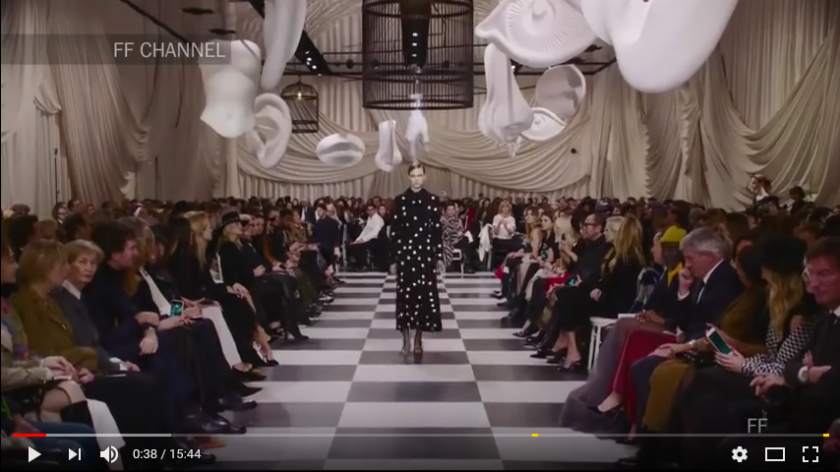
I might have digressed a bit, so I’ll return to the topic of the essay, which is drawing of the human body and head.
I’ve noticed I often get interesting marks when I draw quick. A couple of live drawing sessions I attended when I just started the chapter, were interesting as the model changed her position every 10 minutes or so. I had no choice but to draw very quickly, make provisional kind of marks, be satisfied with only basic shapes. And the results were not that bad… Perhaps because I got very little chance to overwork the drawings.. I think I sometimes overwork my drawing so that they look busy but in a flat and meaningless type of way. Besides, in those live drawing sessions, I enjoyed drawing curvy models with a relatively soft pencil (who doesn’t!?)
In my most recent drawing-paintings, but also in ‘pure’ drawings as well, I started treating negative space as ‘real’ space. So now it’s more ‘space’ and less ‘negative’ for me, if it makes sense. I try to apply varying shading to show areas of darkness and light in a more ambient way. Also, sometimes I make up the background and draw some patterns there, although they are just in my head. So, it becomes half-live drawing half-imaginative experience. I like it – it can sometimes affect the interpretation of my work (when I’m successful with my experiments of course).
Drawing figures in movement was a wonderful and transformative experience. Often, I drew with my eyes off the paper trying to memorise the elusive movement and body shapes. Drawing movement coincided with the period of intense fascination with contemporary dance. It led me to explore the work of local and international contemporary choreographers. It’s mesmerising how body can follow the music and assume sometimes ‘non-human like’ shapes. I think transcending your body and its physical limitation is at the core of dance. It probably feels special to be creative with nothing else but your body. Be lead by the music and feelings no matter the dark places it might lead you to. Would be interesting to explore it all further in my drawing-painting adventure.
Drawing from memory was one of the most challenging and less satisfying experiences… What helped me most is remembering an emotion that I connected with the scene. For instance, what worked for me is drawing a serious-looking bold man with earing in his ear rocking in a chair. It worked because I connected an emotion (amazement) to it. How refreshing to see a serious-looking man giving his inner kid a free reign for a few moments. Manly and openly vulnerable – not often to be found in one person, in my experience at least. What didn’t work was trying to draw a model as if I’m at a live-drawing session. The drawing came out predictable and stale. I just cannot imagine the body that well yet.
Now a few paragraphs about the work that I’m submitting for this assignment.
The first drawing represents a close intimate relationship. It can also represent the multi-layered nature of identity. The base image is my own body print – I covered the upper part of my body in a mixture of ink and red acrylic paint. I guess I wanted to leave my personal physical mark on the drawing, to try using my own body as a tool in my work. One could say that the body print represents me as a person, but also the female side in an intimate relationship. It happens to be the upper part of the body (without the head though) because that’s the part of the body that I feel is used rather often in popular culture as the epitome of the feminine. The value is often placed in parts of the female body that have to do with sexual desire and also reproduction. The drawing of an egg on the right hand-side is meant to represent fertility, but also expectation of society towards women. Then there are two more layers with drawings of a man in a meditating posture, one larger than the other. I made a few sketches of a sitting male model that I could choose from, but for the purpose of this work, I decided to go for the meditating one. I wanted to contrast the outstretched female body (a bit emotionally charged) with a calm and composed male body in a sitting position. On the auto-biographical side, it might represent my relationships with two main male figures in my life – my husband and my father. I haven’t thought about it consciously when making the work, but now that I’m analysing it, it makes a lot of sense.
The second drawing is my self-portrait drawn in a kind of photographic or even cinematic style. Each image of the three represents a frame on the film. This work is about introspection – I look at myself from three sides (maybe I should have done four frames to show all four sides! The back ‘shot’ is currently missing). It’s also about self-criticism as the point of view I chose to look at myself from is not very flattering. I based the drawings on three selfies of myself, that’s the reason why I’m using ‘self’ and ‘looking at myself’ and not ‘they looking at me’. There is no valid reason really as to why I chose the colour scheme that I chose. I think my original idea was to make it black and white series of video stills but I later went for bright yellow colour as a way to make it more eye-catching. As a way of applying self-criticism to this particular work… I think it would have been more powerful to keep it black and white and execute it fully in ink. I guess I used pencil to draw the face(s) in my self-portrait mainly in order to exercise and demonstrate my cross-hatching technique. Also it would be interesting to emphasize more the ‘cinematic’ part. For instance, to draw stills of more continuous movement.
Finally, the third one, the image of a standing half-nude took me the longest to conceptualise but it was the quickest one to draw. Not sure what it tells about the subject of my work or my preparatory research skills… To cut the long story short, first, I was trying to find a picture of a standing nude online, which proved to be very difficult. The search results were often skewed towards pornographic type of images that portray a woman more like an object rather than a person with agency. I searched for so long my eyes started hurting and I was feeling dizzy but I couldn’t find anything worthwhile. In the end, I asked my husband to take a picture of me after the shower. Even though a bit reluctantly, he agreed (it was rather late in the evening). The following day, I drew myself from the photograph. Another interesting fact is that I used coffee grinds to colour my body in the drawing. I’ve been experimenting with unorthodox drawing media lately, as it can add an interesting twist to the work. I like that coffee grinds give my drawing a very specific grainy texture and create a nice contrast to my style of marks. I think the resulting colour represent the colour of my skin rather accurately. It makes part of my identity, even though by ethnicity, I’m considered rather ‘white’.
As to going forward, recently, I got a book of drawings by Nigel Peake titled ‘In the City’. I really liked how he deconstructed things that make up a city but often go completely unnoticed, like a system of pipes or grids in many different forms. To quote Peake, ‘the grid is adopted and changed in every city’. I also found it interesting how he uses ink and watercolour for his architectural-like drawings – an unusual choice in my view. I mostly associate watercolours with romanticism and dreamy landscapes and his drawings look nothing like that.
I got an idea from his work to combine architectural (sometimes abstract) shapes with drawings of people – I did one provisional drawing to start exploring this topic. I’m thinking of maybe using this idea for the assignment in the final chapter of this course, which is about working on an independent project. I’m not sure yet.
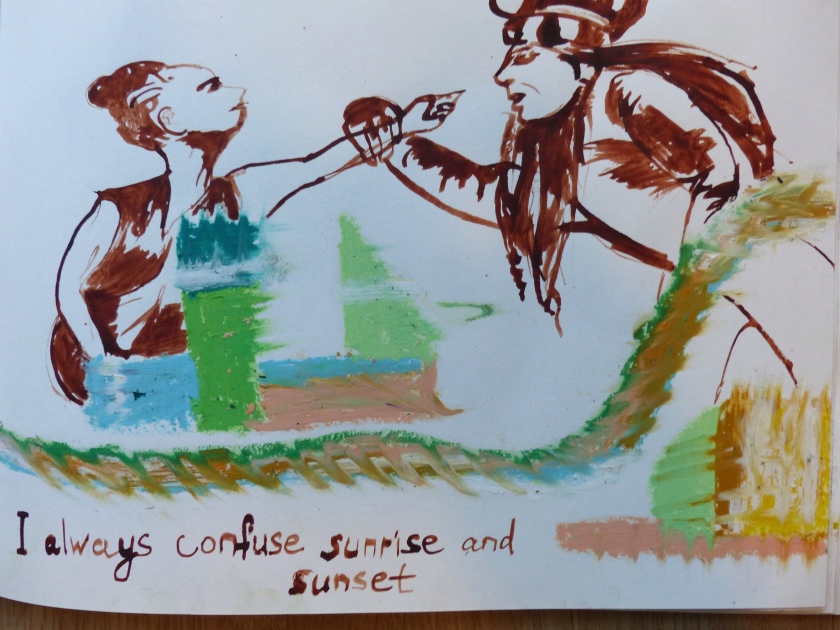
Another thing I’m contemplating for future independent work, is how to use text and drawing together. I don’t want to end up with an illustration to a piece of text, but rather create playful dissonance or harmony between images and words. I have some random ideas already – like writing down overheard phrases that piqued my interest or things I see on posters and other temporary and permanent surfaces around town.
All in all, it was an interesting chapter even though I’ve experienced periods when I temporarily lost interest in subject matter or slowed down my pace. I guess it’s part of my creative process. I’m really looking forward to the next chapter as it offers an opportunity to apply my skills to a longer project and make some in-depth investigation around it. The research and conceptualisation part really excites me as well as producing a body of work that would speak of me me as an artist at this specific point in time.
Preparatory pieces for the assignment:
